A Slightly Obsessed Halloween Special!
The days shorten, the shadows of night creep ever earlier, and the first chill is felt on the evening breeze. The leaves curl upon their branches, soon falling a duskshade rainbow of brown, orange, and deep red, as one’s thoughts, deepening and darkening with the season, turn naturally to… horror movies?
Well, friends, if you’re like me they do!
This Halloween I would like to invite you, fellow film fans, to accompany me on a journey of the imagination into TERROR! and GHOULISH DELIGHT! as we explore the roots, trivia, and fun miscellany of nearly 90 YEARS! of that grandest of all film genres, the horror movie!
So draw the curtains, dim the lights, draw a blanket around your shoulders, and draw a soothing, steaming draught of pumpkin spice latte as we embark upon 31 NIGHTS OF HALLOWEEN!
1st Night: NOSFERATU, A SYMPHONY OF HORROR
(1922, Germany, dir. F.W. Murnau)
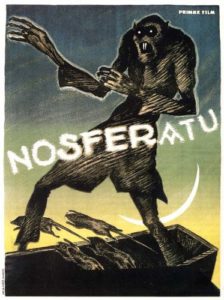 The first ever screen Dracula, unofficially adapted from Bram Stoker’s classic novel, is also probably the finest. In this version, mainly because fledgling German film studio Prana could not secure the rights to the source material,“Dracula” becomes “Orlok,” “Harker” becomes “Hutter,” “Renfield” becomes “Knock,” and the settings of the novel are changed from Transylvania and London of the 1890’s to Slovakia and the town of Wisborg in 1838—even the word “nosferatu,” derived from similar legends of bloodthirsty ghosts in Central European folklore, is used in favor of “vampire”—but no screen adaptation of Dracula made since has matched this silent film for its shadowy compositions and dream-like air of dread. Max Schreck’s Count Orlok—pale, emaciated, with rodent-like teeth and long sharp talons for hands; more rat or spider than human—once seen, is not easily forgotten…
The first ever screen Dracula, unofficially adapted from Bram Stoker’s classic novel, is also probably the finest. In this version, mainly because fledgling German film studio Prana could not secure the rights to the source material,“Dracula” becomes “Orlok,” “Harker” becomes “Hutter,” “Renfield” becomes “Knock,” and the settings of the novel are changed from Transylvania and London of the 1890’s to Slovakia and the town of Wisborg in 1838—even the word “nosferatu,” derived from similar legends of bloodthirsty ghosts in Central European folklore, is used in favor of “vampire”—but no screen adaptation of Dracula made since has matched this silent film for its shadowy compositions and dream-like air of dread. Max Schreck’s Count Orlok—pale, emaciated, with rodent-like teeth and long sharp talons for hands; more rat or spider than human—once seen, is not easily forgotten…
Haunting Miscellany!
Two elements that substantially set apart director Murnau’s vision of horror from then-contemporary filmmaking—the postwar German film industry of the Weimar era—is his use of location space, both real and constructed, and lighting, both natural and artificial. Due to economic and technical restraints of the period, many films from that era—most famously The Cabinet of Dr. Caligari in 1919—were comparably stagebound and static, with the camera moored to the ground, unmoving, for each individual shot or scene and with heavily-stylized stage space—copying the then-contemporary aesthetic distortions of Expressionism—standing in for real locations. Murnau broke with these traditions by finding no-less Expressionistic ‘opportunities’ in real-life locations: most notably, the gothic architecture of Orava Castle and medieval-like villages of Lübeck and Wismar.
But most of all, it’s Murnau’s collaboration with lighting cameraman Fritz Arno Wagner that so brilliantly found creative ‘expression’ in, say, the film’s most famous sequence where Count Orlok’s nightmarish shadow slowly creeps up Hutter’s staircase, oozes through Frau Hutter’s bedroom, rises up across her scantily-clad frame, and seizes her heart in its phantasmal pincer-grip!
2nd Night: THE PHANTOM OF THE OPERA
(1925, Universal, dir. Rupert Julian)
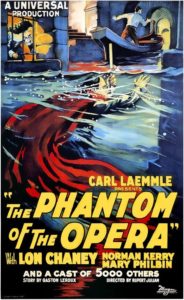 Lon Chaney’s signature role of “Erik the Phantom” takes center stage in this magnificent silent production, whose success served to inspire Universal Studio’s long series of horror movies in the early 1930’s. Lon Chaney went on to essay a whole slew of other “extreme characterizations” for a rival studio, MGM—where he played such roles as a cross-dressing ventriloquist (The Unholy Three, 1925), an armless knife-thrower (The Unknown, 1927), a paraplegic magician (West of Zanzibar, 1928), and various homicidal clowns (He Who Gets Slapped, 1924; Laugh, Clown, Laugh, 1928)—but this is the role for which he’ll always be remembered.
Lon Chaney’s signature role of “Erik the Phantom” takes center stage in this magnificent silent production, whose success served to inspire Universal Studio’s long series of horror movies in the early 1930’s. Lon Chaney went on to essay a whole slew of other “extreme characterizations” for a rival studio, MGM—where he played such roles as a cross-dressing ventriloquist (The Unholy Three, 1925), an armless knife-thrower (The Unknown, 1927), a paraplegic magician (West of Zanzibar, 1928), and various homicidal clowns (He Who Gets Slapped, 1924; Laugh, Clown, Laugh, 1928)—but this is the role for which he’ll always be remembered.
Haunting Miscellany!
Any case for silent horror movies being about ten times more creepy than their sound movie counterparts simply cannot be made without referencing the famous “reveal” by actress Mary Philbin, playing the object of the Phantom’s obsessions, Christine Daae, of the gross deformities lying under Lon Chaney’s mask. The suspense built around this moment is at such a fever pitch of melodramatic emotion that the audience could have very easily been disappointed had Chaney’s make-up not been up to the standard of his previous characterization for Universal, that of the Hunchback in the 1923 production of The Hunchback of Notre Dame, but it’s that magical mixture of performance and chameleon-like appearance for which Chaney was so renowned, the look on his skull-like and deformed features suggests just as much pathos as it does fright, that makes the scene so terrifying—and even touching.
3rd Night: L’AGE D’OR
(1930, France, dir. Luis Buñuel)
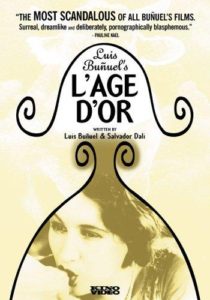 A Surrealist art film may seem an odd choice on a list of Halloween-themed movies, but director Buñuel’s savage attack on the manners and mores of high society—and, especially, organized religion—is (or ‘was’, at least) as shocking and outrageous as any horror movie. The avant-garde, by its very definition, has always raised the bar for that which follows, and it’s interesting to note how genre filmmaking, especially the horror genre, assimilated its transgressing (and transgressive) techniques. And I know that might possibly sound boring, but any movie that features a guy randomly kicking a small dog AND knocking over a blind guy AND throwing a full-regalia Catholic Cardinal out the window can’t be all bad!
A Surrealist art film may seem an odd choice on a list of Halloween-themed movies, but director Buñuel’s savage attack on the manners and mores of high society—and, especially, organized religion—is (or ‘was’, at least) as shocking and outrageous as any horror movie. The avant-garde, by its very definition, has always raised the bar for that which follows, and it’s interesting to note how genre filmmaking, especially the horror genre, assimilated its transgressing (and transgressive) techniques. And I know that might possibly sound boring, but any movie that features a guy randomly kicking a small dog AND knocking over a blind guy AND throwing a full-regalia Catholic Cardinal out the window can’t be all bad!
Haunting Miscellany!
The outrage with which this film was greeted, a mere 4 days after its premiere at Studio 28 in Paris on November 29, 1930, resulted not only in property damage and assault—a militant right-wing group threw ink at the screen and physically attacked members of the audience—but also priceless works of Surrealist art by Dalí (the film’s credited co-writer), Man Ray, Miró and others being slashed, stomped upon, and set fire to! The upshot of this brouhaha was the film was immediately yanked from distribution and subsequently banned. The film would not be exhibited publicly again for another 30 years, during which time Spanish-born filmmaker Buñuel spent most of the intervening period as a low-budget filmmaker in Mexico.
4th Night: DRACULA
(1931, Universal, dir. Tod Browning)
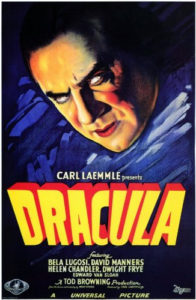 Bela Lugosi IS “Count Dracula” in the film that officially kick-started Universal’s famous series of horror movies. Director Tod Browning’s and producer Carl Laemmle, Jr.’s original choice for the title role had been none other than Browning’s old colleague at MGM, Lon Chaney—between whom had been one of the most famous screen partnerships of all time, and who had previously directed Chaney as a (fake) vampire in the (now lost) 1928 production of London After Midnight—but Chaney’s untimely death from lung cancer in August 1930 forced them to find another suitable candidate for whom “the blood is the life”! Released on Valentine’s Day 1931, the magnetic performance of a 48-year-old Hungarian émigré, suggesting the mountainous wastes and untamed wilderness of ancient Transylvania in every v-accented utterance, was widely reported as having sent the (mainly) female portion of its audiences into “fainting spells” and “paroxysms of erotic delight”. (Seriously!)
Bela Lugosi IS “Count Dracula” in the film that officially kick-started Universal’s famous series of horror movies. Director Tod Browning’s and producer Carl Laemmle, Jr.’s original choice for the title role had been none other than Browning’s old colleague at MGM, Lon Chaney—between whom had been one of the most famous screen partnerships of all time, and who had previously directed Chaney as a (fake) vampire in the (now lost) 1928 production of London After Midnight—but Chaney’s untimely death from lung cancer in August 1930 forced them to find another suitable candidate for whom “the blood is the life”! Released on Valentine’s Day 1931, the magnetic performance of a 48-year-old Hungarian émigré, suggesting the mountainous wastes and untamed wilderness of ancient Transylvania in every v-accented utterance, was widely reported as having sent the (mainly) female portion of its audiences into “fainting spells” and “paroxysms of erotic delight”. (Seriously!)
Haunting Miscellany!
OK, I’m gonna go out on a limb here and say… NOT as great a movie as its reputation might suggest. The first 25 minutes or so—on the Vorgo Pass, in Dracula’s Castle, and aboard the ‘good ship’ Demeter—ARE truly atmospheric and eerie… which, unfortunately, only serves to make the next 45 minutes so disappointing. Edward Van Sloan’s stalwart Van Helsing and Dwight Frye’s hysterically insane Renfield aside, boring second leads and endlessly talky scenes (unimaginatively shot in indifferently-designed drawing rooms) nearly sink the last 2/3rds of the movie. The film DOES end on a high-note, with lots of action up and down the winding steps of Charles D. Hall’s magnificent Carfax Abbey set, but the real reason this movie is a must-see is LUGOSI! himself, whose old-world charm and otherworldly charisma make him the ultimate Hollywood screen vampire.
5th Night: FRANKENSTEIN
(1931, Universal, dir. James Whale)
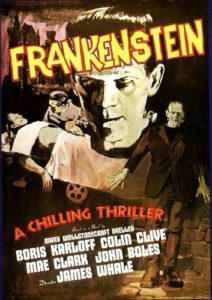 Following a “friendly word of warning” from actor Edward Van Sloan—playing Dr. Waldman—the film opens with the good doctor (Colin Clive) and his hunchback assistant (Dwight Frye) digging up a corpse at the local cemetery (“He’s just resting – waiting for new life to come!”), and, subsequently, cutting down a recently-executed man from the gallows… and we’re off! Director James Whale, in his first horror movie, refashioned the articulate, agile creature of Mary Shelley’s classic into a mute, stumbling monster… and THAT’S what people remember whenever anyone mentions “Frankenstein.” Whale and makeup artist Jack Pierce’s iconic design for “The Monster”—with its flat and angled head, neck bolts, and scars—is still scary, but it took the soulful performance of an actor originally billed as “?” (Boris Karloff) to suggest a glimmer of humanity behind the brutality and ugliness. From its ghoulish opening scene to its famous burning windmill climax, this early sound classic remains just as creepy and terrifying as when it premiered 82 year ago!
Following a “friendly word of warning” from actor Edward Van Sloan—playing Dr. Waldman—the film opens with the good doctor (Colin Clive) and his hunchback assistant (Dwight Frye) digging up a corpse at the local cemetery (“He’s just resting – waiting for new life to come!”), and, subsequently, cutting down a recently-executed man from the gallows… and we’re off! Director James Whale, in his first horror movie, refashioned the articulate, agile creature of Mary Shelley’s classic into a mute, stumbling monster… and THAT’S what people remember whenever anyone mentions “Frankenstein.” Whale and makeup artist Jack Pierce’s iconic design for “The Monster”—with its flat and angled head, neck bolts, and scars—is still scary, but it took the soulful performance of an actor originally billed as “?” (Boris Karloff) to suggest a glimmer of humanity behind the brutality and ugliness. From its ghoulish opening scene to its famous burning windmill climax, this early sound classic remains just as creepy and terrifying as when it premiered 82 year ago!
Haunting Miscellany!
I think there’s no better way to describe the legacy of this film than to mention a 1973 Spanish movie called The Spirit of the Beehive (dir. Victor Erice). Spirit is set at the end of the Spanish Civil War and concerns a 6-year-old girl who sees Frankenstein for the first time when a traveling carnival organizes a makeshift showing of the film in her small village. Frightened by the movie (especially a scene where the monster accidentally kills a little girl—a scene which has frequently been excised from many existing prints of the original film), she becomes obsessed with the monster character, who dominates her dreams and imaginings over the next weeks, even becoming a sort of ‘imaginary friend’… and to reveal more would be a disservice. I can’t think of many better screen portrayals of childhood—how a kid actually thinks and feels—and, especially, how kids interpret what they see up on the big screen. It’s a unique and poetic film, which should be better known, that is a testament to Frankenstein‘s place in the popular imagination.
6th Night: FREAKS
(1932, MGM, dir. Tod Browning)
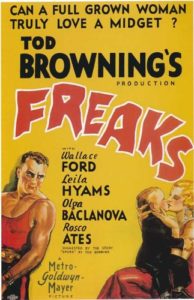 More than 80 years after its initial (limited) release, Dracula director Tod Browning’s tale of a troupe of circus sideshow “freaks” and their violent revenge on two “normal”-bodied tormentors is still one of the most controversial horror movies ever made. From performers billed as “The Living Torso” (Prince Randian), “Half Boy” (Johnny Eck), and, collectively, “The Pinheads” (Eliva and Jenny Lee Snow; and two other uncredited performers with the neurodevelopmental disorder, microcephaly), Freak‘s deep cast of real-life sideshow artists, along with material thematically championing inner beauty over deformity of character (“Gooba-gobble! Gooba-gobble! We accept her! One of us!”), proved a bit strong for Depression-era audiences expecting “monsters” to be portrayed as inherently evil. Censors cut the film by a half-hour… and eventually banned it altogether. The film found new life after being rediscovered—and heralded as a ‘cult classic’—in the late 60’s. Celebrated today for its unique atmosphere and rather progressive, and even celebratory, view of “differently-abled” people, Freaks is one of the few films from this era that succeeds today precisely because it was so roundly rejected when it was made!
More than 80 years after its initial (limited) release, Dracula director Tod Browning’s tale of a troupe of circus sideshow “freaks” and their violent revenge on two “normal”-bodied tormentors is still one of the most controversial horror movies ever made. From performers billed as “The Living Torso” (Prince Randian), “Half Boy” (Johnny Eck), and, collectively, “The Pinheads” (Eliva and Jenny Lee Snow; and two other uncredited performers with the neurodevelopmental disorder, microcephaly), Freak‘s deep cast of real-life sideshow artists, along with material thematically championing inner beauty over deformity of character (“Gooba-gobble! Gooba-gobble! We accept her! One of us!”), proved a bit strong for Depression-era audiences expecting “monsters” to be portrayed as inherently evil. Censors cut the film by a half-hour… and eventually banned it altogether. The film found new life after being rediscovered—and heralded as a ‘cult classic’—in the late 60’s. Celebrated today for its unique atmosphere and rather progressive, and even celebratory, view of “differently-abled” people, Freaks is one of the few films from this era that succeeds today precisely because it was so roundly rejected when it was made!
Haunting Miscellany!
A deeply personal project for director Browning, who in his youth had literally run away from home and joined the circus, it was also the film that effectively ended his career in Hollywood. Though, appropriate for the director of Dracula, he’d “rise” again for at least two more moderate successes at MGM in the mid-30’s (Mark of the Vampire and The Devil-Doll), Browning, the director of horror legend Lon Chaney’s greatest roles (The Unholy Three, West of Zanzibar, London After Midnight, etc.) spent the rest of his life (he lived until 1962) in comparative obscurity to the renown he once enjoyed. With Freaks, Browning’s documentary-like dedication to honestly portraying the “inner lives” of the sideshow performers—Prince Ramadian, “The Living Torso”’s ability to light a cigarette without hands or legs, Johnny Eck, “The Half Boy”’s astonishing feats of gymnastic ability without the lower part of his body; even social and married life(!) for the two very temperamentally-different sisters, “The Siamese Twins” Daisy and Violet Hilton—proves the film, along with Browning’s vision, was entirely non-exploitative and, indeed, years ahead of its time.
7th Night: MURDERS IN THE RUE MORGUE
(1932, Universal, dir. Robert Florey)
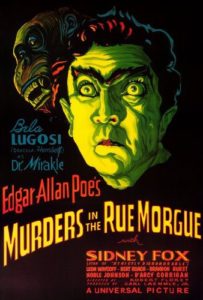 About all this movie has in common with the Poe story, besides the title, is the identity of the ‘murderer.’ Otherwise, the film’s story—and broadly expressionistic set-design—seems mainly to have been inspired by the post-WWI German classic, The Cabinet of Dr. Caligari (1919)… with ‘murdering ape’ substituting for ‘murdering sleep-walker.’ Bela Lugosi plays a carnival barker/biologist called “Dr. Mirakle” who, in 1840’s France, sets out to prove his evolutionary theories by kidnapping prostitutes and injecting them with the blood of his caged ape. The film is also noted for a particularly violent abduction scene that (vaguely) suggests interspecies, um, “improprieties.” Pretty strong stuff—especially for a classic Hollywood studio film. (Though, in many shots, the obvious ‘guy in an ape suit’ does tend to be distracting for modern audiences – but, for the right sort of audience today, should actually prove a good deal of the fun!)
About all this movie has in common with the Poe story, besides the title, is the identity of the ‘murderer.’ Otherwise, the film’s story—and broadly expressionistic set-design—seems mainly to have been inspired by the post-WWI German classic, The Cabinet of Dr. Caligari (1919)… with ‘murdering ape’ substituting for ‘murdering sleep-walker.’ Bela Lugosi plays a carnival barker/biologist called “Dr. Mirakle” who, in 1840’s France, sets out to prove his evolutionary theories by kidnapping prostitutes and injecting them with the blood of his caged ape. The film is also noted for a particularly violent abduction scene that (vaguely) suggests interspecies, um, “improprieties.” Pretty strong stuff—especially for a classic Hollywood studio film. (Though, in many shots, the obvious ‘guy in an ape suit’ does tend to be distracting for modern audiences – but, for the right sort of audience today, should actually prove a good deal of the fun!)
Haunting Miscellany!
Horror aficionados are undoubtedly aware that Lugosi and director Robert Florey were the first star/director team assigned to Frankenstein and, indeed, that test footage and promotional material was shot depicting the legendary Hungarian horror star in full dress and make-up in the role that later went to his rival at Universal, Boris Karloff. Comparing this movie to the sterling example of Hollywood horror that became the James Whale and Boris Karloff Frankenstein undoubtedly proves that the producers at Universal made the right choice for their director and star with their stronger property, reassigning Lugosi and Florey to the less-prominent Murders, but has still done little to stifle speculation as to what a Lugosi Frankenstein might have been like. Lugosi eventually did play The Monster, opposite Lon Chaney, Jr. in 1943’s Frankenstein Meets the Wolf Man, but the Florey/Lugosi Murders in the Rue Morgue remains a worthy and atmospheric effort for Universal Studios in their horror movie-making prime.
8th Night: VAMPYR
(1932, Germany/France, dir. Carl Theodor Dreyer)
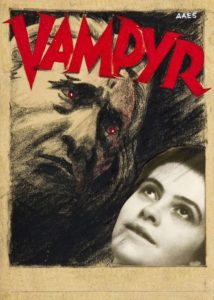 The great Danish director Carl Theodor Dreyer’s follow-up to his monumental silent film, The Passion of Joan of Arc (1928), suffered in comparison during its original release, but has been reevaluated since as a worthy successor to his earlier masterpiece. Where Passion took as its subject the persecution and martyrdom of a saint, the deeply spiritual filmmaker here explores the corruption of the soul and, through extension, the contagion of evil—but, y’know, with vampires and stuff. Along with F.W. Murnau in Nosferatu, Dreyer creates an atmosphere of old-world superstition and dread, complete with frighteningly-realistic explanatory “text” interspersed throughout—included in both films’ handy, Gothic-font Vampire Guide books—that makes for perfect late-night viewing. Adapted from J. Sheridan Le Fanu’s 1871 short novel, Carmilla (pre-dating Bram Stoker’s Dracula by almost 3 decades), and best viewed, perhaps, between the hours of one and three in the morning, Dreyer’s film is truly unique for its dream-like atmosphere, which evokes a shadowy nether world between nightmare and waking. (Personally, I think the film’s long-shot, tracking view from inside a coffin, courtesy of legendary lighting cameraman Rudolph Maté, is possibly the most terrifying image, and sequence, ever committed to film.) A one-of-a-kind masterpiece.
The great Danish director Carl Theodor Dreyer’s follow-up to his monumental silent film, The Passion of Joan of Arc (1928), suffered in comparison during its original release, but has been reevaluated since as a worthy successor to his earlier masterpiece. Where Passion took as its subject the persecution and martyrdom of a saint, the deeply spiritual filmmaker here explores the corruption of the soul and, through extension, the contagion of evil—but, y’know, with vampires and stuff. Along with F.W. Murnau in Nosferatu, Dreyer creates an atmosphere of old-world superstition and dread, complete with frighteningly-realistic explanatory “text” interspersed throughout—included in both films’ handy, Gothic-font Vampire Guide books—that makes for perfect late-night viewing. Adapted from J. Sheridan Le Fanu’s 1871 short novel, Carmilla (pre-dating Bram Stoker’s Dracula by almost 3 decades), and best viewed, perhaps, between the hours of one and three in the morning, Dreyer’s film is truly unique for its dream-like atmosphere, which evokes a shadowy nether world between nightmare and waking. (Personally, I think the film’s long-shot, tracking view from inside a coffin, courtesy of legendary lighting cameraman Rudolph Maté, is possibly the most terrifying image, and sequence, ever committed to film.) A one-of-a-kind masterpiece.
Haunting Miscellany!
As I have just one more film about vampires planned for this list (and it’ll be a comedy) I’d like to briefly make a point here about what a vampire SHOULD be… their being so popular these days and all. In films like Nosferatu, Dracula, and Vampyr, vampires are much more than mere monsters, and their presence suggest actual themes (you’ve heard of those?) like spiritual degeneration, pestilence, eternal damnation… and so on. Though the observation is at least three years out of date by now, I believe that true horror fans should continue, steadfastly, to maintain that vacant, hollow-eyed pretty boys (and girls) ‘emoting’ through soap-level melodramatics should NEVER a true vampire tale make.
9th Night: THE MOST DANGEROUS GAME
(1932, RKO, dir.(s) Ernest B. Schoedsack & Irving Pichel)
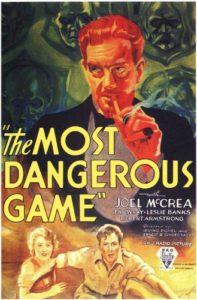 Based on Robert Connell’s short story of the same name—which is about a Russian count who lures shipwrecked travelers to his remote island paradise and then hunts them for sport—this is another pretty potent Pre-Code* movie with a lotta sex and a lotta violence (for its day, at least). A scene where Leslie Banks (as “Count Zaroff”) coolly enjoys a cigarette while contemplating “further actions” towards the virginal heroine (Fay Wray), or when the unwary travelers enter the Count’s “trophy room” and encounter a human head mounted to the wall, or another scene where the hero (played by a young Joel McCrea) breaks an assailant’s back over his own (you actually hear it CRACK!) are all still fairly shocking. Producers Merian C. Cooper and Ernest B. Schoedsack made this movie concurrent to their BIG production of King Kong (1933) and, in addition to casting two actors from that film (Fay Wray & Robert Armstrong), also shot it on the ‘big ape’ movie’s famed jungle sets. From the shipwreck in shark-infested waters that opens the film to the Count being torn apart by his pack of wild dogs at its climax, this is classic Hollywood at its most grisly and extreme.
Based on Robert Connell’s short story of the same name—which is about a Russian count who lures shipwrecked travelers to his remote island paradise and then hunts them for sport—this is another pretty potent Pre-Code* movie with a lotta sex and a lotta violence (for its day, at least). A scene where Leslie Banks (as “Count Zaroff”) coolly enjoys a cigarette while contemplating “further actions” towards the virginal heroine (Fay Wray), or when the unwary travelers enter the Count’s “trophy room” and encounter a human head mounted to the wall, or another scene where the hero (played by a young Joel McCrea) breaks an assailant’s back over his own (you actually hear it CRACK!) are all still fairly shocking. Producers Merian C. Cooper and Ernest B. Schoedsack made this movie concurrent to their BIG production of King Kong (1933) and, in addition to casting two actors from that film (Fay Wray & Robert Armstrong), also shot it on the ‘big ape’ movie’s famed jungle sets. From the shipwreck in shark-infested waters that opens the film to the Count being torn apart by his pack of wild dogs at its climax, this is classic Hollywood at its most grisly and extreme.
Haunting Miscellany!
Released in the latter third of 1932, Game comes at the forefront of a group of violent melodramas set in exotic locales, which also includes Paramount’s Island of Lost Souls and MGM’s Kongo, that effortlessly transgressed the then-acceptable boundaries of ‘decorum and restraint’ with some good ol’ fashioned sadism and frank sexuality! Referencing the ‘*’ above, the Pre-Code era in Hollywood refers to the period prior to 1934 when the Motion Picture Production Code, drafted in 1930, had yet to take full effect. As such, studios and filmmakers alike had a much freer hand during this period to have a character actually say a line like, “Kill, then love! When you have know that you have known ecstasy.” and then proceed to have that same character immediately act upon that intention! The murderous lechery of a character like Count Zaroff may have been almost impossible to portray a scant year and a half after the release of this film, but the ‘dance’ around the Production Code that filmmakers engaged in after its industry-wide adoption—“putting one past the Hays Office”—also made for some no-less interesting choices when violence and sexuality could merely be suggested.
10th Night: THE MUMMY
(1932, Universal, dir. Karl Freund)
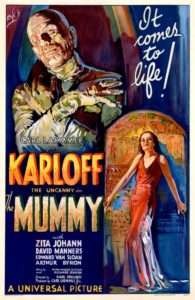 After “Dracula” and “Frankenstein’s Monster”, Karloff’s “Imhotep, The Mummy” is frequently singled-out among Universal Studio’s great monster creations. Edward Van Sloan, following his roles in Draculaand Frankenstein, once again plays the aging professor/doctor character (this one is named “Muller”) in dogged, unflappable pursuit of an unknown, unholy terror—this time beneath the ancient sands of Egypt!
After “Dracula” and “Frankenstein’s Monster”, Karloff’s “Imhotep, The Mummy” is frequently singled-out among Universal Studio’s great monster creations. Edward Van Sloan, following his roles in Draculaand Frankenstein, once again plays the aging professor/doctor character (this one is named “Muller”) in dogged, unflappable pursuit of an unknown, unholy terror—this time beneath the ancient sands of Egypt!
As the reincarnated object of The Mummy’s desire, the entrancing and otherworldly Zita Johann makes quite the impression in the type of role, the stereotypical “woman in peril,” that usually makes no impression at all; here actually justifying The Mummy’s own dogged, unflappable pursuit of his beloved (in the film’s famed “mirror of time” flashback sequence to Ancient Eqypt) across 4,000 years of human history. Makeup genius Jack Pierce out-did himself with his strongly textured mummy design—whose wraps, bandages, and 4000 yr. old dusty/flaking ‘skin’ (like desert sand crumbling under the hot Egyptian sun!) set a standard for all future screen mummies.
As the first Universal horror property not based on an established literary classic, as was the case with Bram Stoker’s Dracula or Mary Shelley’s Frankenstein, The Mummy has nonetheless proved singularly, and appropriately, deathless; inspiring four sequels, a late 40’s de rigueur Abbott & Costello “encounter,” a four-film Hammer series in the 60’s, and, of course, the latter-day action/adventure special-effects extravaganzas.
Haunting Miscellany!
Director Karl Freund, the German cameraman of such classics as F.W. Murnau’s The Last Laugh (1924) and Fritz Lang’s Metropolis (1927), was instrumental in establishing the unique look and feel for many of these early 30’s Universal classics and, indeed, as the film’s credited cinematographer, had practically taken over production on the previous year’s Dracula when the film’s credited director, Tod Browning, suffered a mysterious “infirmity” (possibly crippling depression) mid-way through production. “German Expressionism” is perhaps an overused, and often misapplied, critical, um, ‘expression’ used to describe the shadowy lighting style and jutting, jagged-edged set design of these early horror movies, but, in the case of those produced at Universal between 1931 – 1935, the term is actually quite justified.
Not only did Universal directors like James Whale and cameramen like Arthur Edeson take specific visual cues from the films of F.W. Murnau, Paul Leni, Fritz Lang et al., but the thematic treatment of insanity, as a metaphor for human contact with the Unknown, is as equally well-represented in their Hollywood counterparts as when, most famously, the entire narrative for 1919’s The Cabinet of Dr. Caligari is revealed ::SPOILER!:: to be the fantasy of a madman.
Here, it’s a young actor named Bramwell Fletcher, playing archeology assistant “Ralph Norton,” who, reading an incantation from an ancient scroll, unwarily awakens The Mummy from its ageless sleep of death and lets loose with perhaps the most blood-curdling laugh of madness in film history when a dust-covered, shroud-wrapped palm is placed on his shoulder! As with their Expressionistic forbears, style and narrative collide here to create a moment of truly pulse-pounding terror.
11th Night: THE INVISIBLE MAN
(1933, Universal, dir. James Whale)
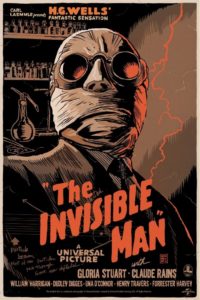 Director Whale’s third horror movie is a reasonably close adaptation of the H.G. Wells science-fiction novel, refashioned (slightly) as a ‘tale of the macabre.’ Whale’s trademark mixture of humor and horror finds its most black, for the former, and disturbing, for the latter, iteration as a once dedicated and driven scientist is transformed into a cackling, megalomaniacal monster by the, um, ‘hidden’ side-effects of invisibility.
Director Whale’s third horror movie is a reasonably close adaptation of the H.G. Wells science-fiction novel, refashioned (slightly) as a ‘tale of the macabre.’ Whale’s trademark mixture of humor and horror finds its most black, for the former, and disturbing, for the latter, iteration as a once dedicated and driven scientist is transformed into a cackling, megalomaniacal monster by the, um, ‘hidden’ side-effects of invisibility.
In perhaps the most distinctive debut in film history, the great Claude Rains ‘appears’ as the disembodied voice, wrapped in surgical bandages… and MAD! MAD! MAD! Scenes set in contemporary English country inns, rural police stations and small village squares are particularly striking in contrast to other more exotic or ‘mythic’ horror films of the period—AND authentic: Whale came from a working-class English background and infused the film with a sharp sense of time and place.
Of particular note is the film’s visual effects—courtesy of matte processing and precision-timed wires—that give the ‘illusion,’ or its lack, of a one-man force of total destruction and chaos… Indeed, a kill-crazy rampage that ends with the vengeance-driven deaths of a colleague, several police officers, and an entire load of passengers (aboard a derailed train), this might very well be the highest body count of any horror movie to this point in cinematic history!
Haunting Miscellany!
This was cinematographer Arthur Edeson’s third and final collaboration with director Whale, following Frankenstein in 1931 and The Old Dark House in 1932. It seems appropriate that Edeson should have worked on ¾ of Whale’s four film-contribution to the horror genre, not only establishing the shadowy compositions and bold framing of Whale’s signature visual style, but also creating the unique atmosphere that supported the larger-than-life (or ‘death,’ for that matter) characterizations of actors like Colin Clive, Boris Karloff, and Claude Rains.
(Indeed, if you should ever catch their previous collaboration, the literally dripping-with-atmosphere Grand Guignol thriller, The Old Dark House— which I would highly suggest—the success of that film is entirely supported by its bewildering succession of grotesques, each more bizarre than the last!)
Edeson, whose career stretched back to the mid-1910’s, moved on to MGM and, eventually, Warner Brothers where he achieved a career high photographing, in succession, The Maltese Falcon (1941), Casablanca (1942), and Across the Pacific (1942), providing a clear stylistic link between horror films of the 1930’s and the wartime melodramas and (nascent) film noir of the 1940’s.
12th Night: THE BLACK CAT
(1934, Universal, dir. Edgar G. Ulmer)
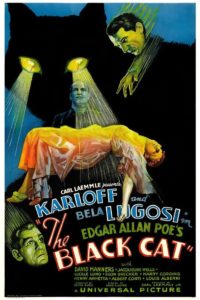 “Suggested by the immortal Edgar Allan Poe classic,” this is another adaptation of Poe that has little (or, in this case, absolutely nothing) to do with Poe, but is rather the first big screen team-up of Bela Lugosi and Boris Karloff—who play a ailurophobic (that’s a ‘fear of cats’ to you, bub) psychiatrist and devil-worshipping architect, respectively—facing-off in classic Hollywood’s most undoubtedly macabre (and explicit) ‘game of death.’ The specter of the first World War hangs heavily over this Baroque and heavily-stylized production, with “Engineer Poelzig” (Karloff) and “Dr. Werdegast” (Lugosi) waging battle once more, after an 18-year interval, on the site of a notorious battlefield upon which the evil architect has erected a magnificent Art Deco temple to Satan!
“Suggested by the immortal Edgar Allan Poe classic,” this is another adaptation of Poe that has little (or, in this case, absolutely nothing) to do with Poe, but is rather the first big screen team-up of Bela Lugosi and Boris Karloff—who play a ailurophobic (that’s a ‘fear of cats’ to you, bub) psychiatrist and devil-worshipping architect, respectively—facing-off in classic Hollywood’s most undoubtedly macabre (and explicit) ‘game of death.’ The specter of the first World War hangs heavily over this Baroque and heavily-stylized production, with “Engineer Poelzig” (Karloff) and “Dr. Werdegast” (Lugosi) waging battle once more, after an 18-year interval, on the site of a notorious battlefield upon which the evil architect has erected a magnificent Art Deco temple to Satan!
Director Ulmer’s fluid direction is full of bravura ‘director moments;’ which include a low angle of Karloff gazing at his (pure) object of (impure) desire, and then rack-focusing to a nude statue held in his (foul) clutches; flamboyant blocking/camerawork, as when the camera pans 360 degrees around Karloff’s basement lair (filled with glass displays preserving the corpses of his former lovers!) while he delivers his notable “living dead” monologue; and (then-)innovative use of classical music, enhancing both mood and theme with selections from Beethoven, Tchaikovsky, and Mendelssohn. In total, Ulmer’s bracing style serves to elevate these melodramatic goings-on to the level of opera. If any horror or genre picture from this period deserves to be called a masterpiece, this may be it!
Haunting Miscellany!
Regarding “no-less interesting [writing/directorial] choices when violence and sexuality could merely be suggested,” Ulmer’s The Black Cat, which at various points in its wildly disturbing narrative suggests such thematic elements as sadism, necrophilia, devil worship, genocide, and (implied) incest, undoubtedly begs the question: how could this movie ever have been made after the advent of the Production Code in January 1934? (In other words, how in heck did they get away with it?)
Released 5 months after the Production Code was in full swing, one might assume that nascent Hollywood director Edgar G. Ulmer and screenwriter “Peter Ruric” (a pseudonym for the hard-boiled mystery writer, Paul Cain) are “dressing up” the lurid atmosphere with high culture, pop psychology, and thematic elements relating to war and its legacy to the point where Joseph I. Breen and the boys at the Hays Office (again, more shorthand for screen censorship) musta simply overlooked, or simply slept through, say, Karloff’s clearly predatory relationship with Lugosi’s daughter, his own former step-daughter OR the film’s frank portrayal of a Satanic Mass, with Karloff presiding over an upturned, double-sided cross as its Priest OR the film’s famous climactic scene where Lugosi literally skins Karloff alive OR…
Well, I could go on, and I’ve nowhere near addressed the question posed above, but suffice it to say, folks, this is a wild one and horror fans should definitely take the chance, a mere 65 minutes of viewing time, to marvel at it!
13th Night: THE BRIDE OF FRANKENSTEIN
(1935, Universal, dir. James Whale)
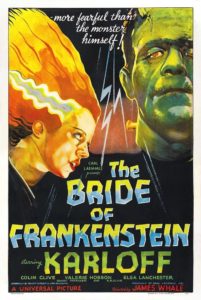 One of those cinematic anomalies where the sequel is better than the original, director Whale—in his 4th (and final) offering to the genre—ramps up the style, horror, AND humor for one of the most purely enjoyable horror movies ever made. Opening with a witty prologue set in the famous “haunted summer” of 1816 by Lake Geneva, with Mary Shelley (Elsa Lanchester), husband Percy Bysshe Shelley, and Lord Byron (“England’s greatest sinner!) meta-discussing the frankly ludicrous notion of a sequel toFrankenstein, the action returns us to the charred ruins of the original’s famous burning (and now entirely burnt) windmill where the mob of angry villagers heedlessly reawaken The Terror (the one name-billed “Karloff) beneath—and so it begins!
One of those cinematic anomalies where the sequel is better than the original, director Whale—in his 4th (and final) offering to the genre—ramps up the style, horror, AND humor for one of the most purely enjoyable horror movies ever made. Opening with a witty prologue set in the famous “haunted summer” of 1816 by Lake Geneva, with Mary Shelley (Elsa Lanchester), husband Percy Bysshe Shelley, and Lord Byron (“England’s greatest sinner!) meta-discussing the frankly ludicrous notion of a sequel toFrankenstein, the action returns us to the charred ruins of the original’s famous burning (and now entirely burnt) windmill where the mob of angry villagers heedlessly reawaken The Terror (the one name-billed “Karloff) beneath—and so it begins!
This time, though, The Monster just wants a ‘friend,’ and the sheer spectacle of the famous ‘Bride’ creation scene—with the buzzing and cracklings of the electrical gizmos, the tilted camera angles, the sinister lighting effects; and all edited rhythmically to Franz Waxman’s powerful score—should not be missed by ANY fan of the genre. And, geez, have I not yet mentioned wild-eyed and bushy-haired Ernest Thesiger as maddest of all scientists, “Dr. Septimus Pretorious”? (How remiss of me.) With his distaff mannerisms and gallows humor—even going so far as in one scene to take his lunch over a young woman’s grave—the Good Doctor doesn’t so much ‘steal’ as ‘stroll mincingly away’ with nearly every scene he’s in: “To a new world of Gods and Monsters!”
As with the original, though, the real laurels go to a performer billed as “?” (Elsa Lanchester; doubling as author Shelley AND her creation’s Bride) who, with white lightning bolt-like streaks zig-zagging up her fright-curled, foot-length hairdo, disdainfully ‘hisses’ her romantic disapproval of the very creature she has been created for, lending itself to one of the most improbably heartbreaking moment in the history of horror movies, much less the history of movies in general!
Haunting Miscellany!
For me, one fascinating aspect of Bride is its re-characterization of Frankenstein’s Monster. Where, in the original, Karloff’s “Monster” had been somewhat sympathetic as a maligned outsider, in the sequel, the Monster is practically saint-like in his persecution, sufferings and torment. Karloff’s soulful performance is the true heart of the film, and, indeed, his entire ‘mission’ throughout the film—which, along the way, involves saving a young shepherdess from drowning, taking (brief) refuge with a gypsy family; culminating in the famous sequence where he shares supper with a blind hermit—is one of simply seeking acceptance in a harsh and cruel world that refuses to accept him.
The Christian imagery director Whale scatters throughout—crucifixes looming large on walls, religious statues and crossed shadows dominating the film’s mise en scene; even going so far, in one scene, as to show the Monster with his arms outstretched while tied to a rail and jeered at by angry villagers—is obviously no accident. And, as if to underline the point, the film ends for the Monster on a note of supreme self-sacrifice… and he’ll even rise again for a sequel (1939’s Son of Frankenstein)!
Who knew? A horror movie tailor-made for Sunday School!
14th Night: WEREWOLF OF LONDON
(1935, Universal, dir. Stuart Walker)
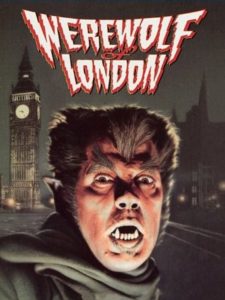 Universal’s first stab (bite? gash? slashing wound?) at a werewolf tale is mostly remembered today for being… well, Universal’s first werewolf movie.
Universal’s first stab (bite? gash? slashing wound?) at a werewolf tale is mostly remembered today for being… well, Universal’s first werewolf movie.
With overtones of Robert Louis Stevenson’s Dr. Jekyll & Mr. Hyde, The Beast crouching just behind the placid exterior of a proper English gentleman (Henry Hull) is unleashed after a botany expedition to the remote mountainous wastes of uncharted Tibet, undertaken to acquire a rare plant specimen called “mariphasa,” gets our intrepid hero attacked (and, of course, bitten) by a werewolf guarding the object of his search. Upon his return, the first full moon rises over the dark city and our celebrated botanist is quickly transformed into a raging, bloodthirsty monster stalking the mist-shrouded streets of Victorian London!
As alluded to above, Hollywood’s first attempt at tackling the werewolf mythos is frequently overshadowed by later, more celebrated, tales of full moon madness. And that’s really a shame ‘cos this early take on lycanthropic mayhem has many imaginative touches—including an atmospheric “London in the Fog” setting—that later versions lack. Also of interest is actor Henry Hull’s striking appearance as the werewolf, who is decidedly taller and leaner than future screen werewolves. Studio makeup artist Jack Pierce’s werewolf design is a scaled-back version of what would appear 7 years later in The Wolfman (up next!).
Haunting Miscellany!
By the latter half of 1935, the public’s enthusiasm for the sort of horror fare Universal had been churning out so relentlessly—and, I should add, brilliantly—over the past four years had waned in favor of bright and witty social comedies such as Columbia’s It Happened One Night (1934).
The studio would still continue to make movies in the “fright” genre in the latter half of the decade, relying increasingly on sequels like Dracula’s Daughter (1936) and Son of Frankenstein (1939), as well as screen team-ups between their biggest horror stars, Boris Karloff and Bela Lugosi, in films like The Raven (1935) and The Invisible Ray (1936), but undoubtedly the largest contributing factor to the studio’s decline during this period was the ousting of young producer, and head of production at Universal from 1928 – 1936, Carl Laemmle, Jr. The son of the studio’s founder, “Junior” Laemmle took control of the studio at the tender age of 20 and, in the early year of the Depression, turned around the then-floundering fortunes of Universal through the major critical and financial success of his 1930 production of All Quiet on the Western Front.
Recalling the success the studio had with two films starring Lon Chaney, on loan from MGM, during the 20’s (1923’s The Hunchback of Notre Dame and 1925’s The Phantom of the Opera), Junior Laemmle re-shifted the focus of the studio during this period towards money-making Tales of the Macabre and, with major emerging stars like Karloff and Lugosi, allowed directors like James Whale and Karl Freund, ably abetted by a whole team of visual effects artists, the space and creative freedom to fashion enduring and iconic horror properties.
15th Night: THE WOLF MAN
(1941, Universal, dir. George Waggner)
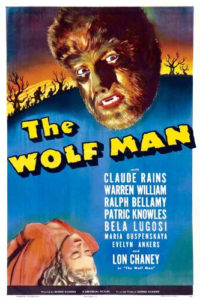 Six years after the studio’s ousting of boy-genius producer “Junior” Laemmle (who, again, had been chiefly responsible for all those great horror movies of the early 30’s), writer Curt Siodmak resurrected (and the choice of words is entirely appropriate) the Universal monster series with his definitive take on the werewolf mythos.
Six years after the studio’s ousting of boy-genius producer “Junior” Laemmle (who, again, had been chiefly responsible for all those great horror movies of the early 30’s), writer Curt Siodmak resurrected (and the choice of words is entirely appropriate) the Universal monster series with his definitive take on the werewolf mythos.
“Larry Talbot” (Lon Chaney, Jr.), an Americanized Welsh/British aristocrat, returns the prodigal son after several years abroad to make amends with his father, “Sir John Talbot” (Claude Rains), and to take his rightful place as heir to the Talbot Estate. The transition proves not without its difficulties, though, after young Talbot, defending a young woman from the village (Evelyn Ankers), is attacked by an unusually hairy traveling gypsy (Bela Lugosi) on the evening of a full moon! (Well, you can probably guess what happens next “when the wolfbane blooms/and the autumn moon is bright.”)
Chaney the Younger proved no-less dedicated to the craft of “extreme characterization” than his protean progenitor and reportedly endured 10 hours daily in make-up master’s Jack Pierce chair, and sitting motionlessly under hot, heavy makeup in front of cinematographer Joseph Valentine camera, to achieve the 10-second on-screen transformation from Man to Wolf Man. If there’s a ‘collective unconscious’ for the movie-going public, I’d say the image of Lon Chaney, Jr.’s snarling, hirsute creature stalking its prey on the misty moors has certainly entered it…
Not to be missed.
Haunting Miscellany!
Along with establishing the werewolf symbol as a ‘starred pentagram,’ Curt Siodmak’s script was also the very first to suggest that a werewolf could only be killed by ‘silver.’ Legend has it Siodmak took his inspiration, oddly enough, from The Lone Ranger radio program which he worked on while writing The Wolfman script. (So, then, if you happen to remember the name of the Lone Ranger’s horse: “Hi-ho, ??????! Away!”)
In addition, Siodmak, the brother of filmmaker Robert Siodmak (1946’s The Killers and 1948’s Criss Cross) also came up with the enduring bit of doggerel quoted above about “[blooming] wolfbane” and “[bright] autumn moon[s],” written to sound like (and often mistaken for) ancient myth that has probably appeared, in one form or other, in every werewolf movie made since.
Indeed, some of my own personal favorites, Joe Dante’s The Howling and John Landis’ An American Werewolf of London (both 1981), would have undoubtedly been impossible to realize without the conventions established by Siodmak’s imagination and vision. As such, it is absolutely astonishing to think that literally everything we today associate with an entire monster mythology was in fact established by a hard-bitten Hollywood scribe on a deadline!
(Just goes to show how great classic Hollywood was, folks.)
16th Night: PHANTOM OF THE OPERA
(1943, Universal, dir. Arthur Lubin)
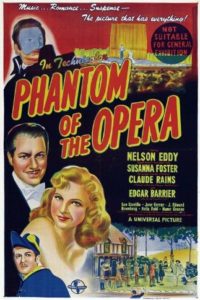 There’s a bit more Opera than Phantom in Universal’s semi-musical remake of the silent Lon Chaney classic, but this grand Technicolor production is well-worth seeing on its own (considerable) merits. From the film’s first shot—a tight close-up on an opera singer that sweeps back over the audience to pause BEHIND the opera house’s ornate chandelier (a bit of foreshadowing, methinks?)—viewers will know they’re in for a real treat.
There’s a bit more Opera than Phantom in Universal’s semi-musical remake of the silent Lon Chaney classic, but this grand Technicolor production is well-worth seeing on its own (considerable) merits. From the film’s first shot—a tight close-up on an opera singer that sweeps back over the audience to pause BEHIND the opera house’s ornate chandelier (a bit of foreshadowing, methinks?)—viewers will know they’re in for a real treat.
Over-complicated melodramatics naturally ensue, with the love triangle between this version’s Christine (Susanna Foster), the opera’s romantic (and nauseating) light baritone (Nelson Eddy), and the unwanted, possessive attentions of the Phantom himself (Claude Rains), providing the dramatic focus of music-inspired Machiavellian mayhem that literally brings the Grand Opera crumbling to its foundations! Ultimately, this version has more in common with lavish theatrical dramas like Powell & Pressburger’s The Red Shoes (1948) and Jean Renoir’s The Golden Coach (1952) than with a rigidly-defined ‘horror movie,’ and Claude Rains’ subdued, neurotic (and pathologically retiring) “Phantom” offers an interesting contrast to previous (and later) incarnations.
Haunting Miscellany!
A personal favorite of director Martin Scorsese, along with prefiguring the treatment of obsessive, destructive love against a lush, historical background in Luchino Visconti’s anti-romantic classic Senso (1954), Universal’s 1943 Phantom, more a musical than a tale of the macabre, is certainly an anomaly among horror movies. (Though Gaston Leroux’s 1909-10 serial seems to suggest it by its very title, one can very well imagine this particular version of ...Opera inspired the 1986 Andrew Lloyd Webber stage musical, still one of the longest-running theatrical productions of its kind.)
Doing much to humanize the actions and motivations of The Phantom—Lon Chaney’s simply being an unrepentant, unstoppable monster—casting a complex, distinguished actor like Claude Rains, for whom jealousy and lovesick humiliation was something of a specialty, ‘ups’ the class and high culture-quotient to the nth degree and bridges Universal’s ambitions for utilizing semi-legitimate opera singers like Susanna Foster and, more prominently, Nelson Eddy with their already-proven track record with horror movies.
Though plans for a sequel—in which, apparently, The Phantom would have survived having the walls of his subterranean lair collapse upon him in order to wreak further vengeance—were scrapped in favor of the mid-40’s umpteenth House of… monster mash-up, it’s interesting to speculate what further ambitions the studio might have realized had they instead ‘gone in’ for high culture once more as opposed to having each of their horror properties (Frankenstein, The Mummy, The Invisible Man…) “meet” Abbott & Costello. (As entertaining as those pictures are!)
17th Night: MEET ME IN ST. LOUIS
(1944, MGM, dir. Vincente Minnelli)
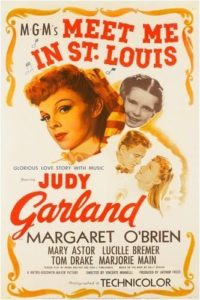 A Judy Garland musical? On a list of Halloween movies?? Yup.
A Judy Garland musical? On a list of Halloween movies?? Yup.
Chronicling a year in the life of a family from St. Louis—culminating in the 1904 World’s Fair—this eternally delightful film is divided into four equally delightful sections, each detailing one eventful day for the “Smith” family in all the four seasons. This is the sort of nostalgic Americana that audiences were clamoring for in late November of 1944—at this point, almost 3 dark years into the most destructive war in human history—and a bit of musical escapism, courtesy of MGM’s knack for idealized portraits of American families and small town life, seemed made to order.
Director Minnelli, then a mere two films into his long tenure as stylist ne plus ultra at the studio, served up his first true masterpiece with St. Louis, filling each frame with the mise en scene of a bygone age—big houses and spacious lawns (which can apparently be supported on a middle class lawyer’s income), the lush furnishings and bric-a-brac of an overstuffed, post-Victorian interior (complete with a parlor chandelier and upright piano)—that will make any viewer want to get in a time machine and travel back to a time when St. Louis could have been called, with a straight face, “a small town.”
After an opening section that takes place at the end of summer, establishing the characters and family dynamics (set to such memorable selections as the title and “Trolley Song”), the second section, “Autumn – 1903,” takes place, appropriately, on Halloween night. Following the youngest Smith child, “Tootie” (Margaret O’Brien), on her first Halloween, we’re privy to an amusing look at the holiday’s American Folk traditions back when its celebration was much more TRICK than TREAT. Bonfires, homemade costumes (as “a horrible ghost” who “died of a broken heart” and a “terrible drunken ghost… murdered in a den of thieves,” respectively), flinging a handful of flour in one’s kindly neighbor’s face and whispering, very tremulously, “I hate you, Mr. Braukoff!”: the lush, atmospheric Technicolor makes each frame of this ‘haunted evening’ pop off the screen like a beautiful oil painting. Great fun.
Haunting Miscellany!
Judy Garland, as second Smith daughter “Esther,” undoubtedly stands in for the All-American Girl here and, indeed, is given some of the most gorgeous Technicolor close-ups—especially during the famed “Trolley Car” sequence (in which I defy anyone to find her blinking even once)—that any actor had received heretofore under the glaring, million-watt lights of the notoriously demanding photographic process. (And that includes Vivien Leigh in Gone with the Wind.)
Not surprisingly, the camera was in love with Miss Garland, and that extends to one of the men behind the camera, director Vincente Minelli, who in fact married her the very next year. One minor quibble, though: her frankly incomprehensible hair, which looks as though a family of birds are nesting on top of it. While not quite as distracting a presence as kid star Margaret “Tootie” O’Brien, whose breathless and shrieking style of child performance has not aged well in the intervening 70 years, the offending pile o’ cascading auburn locks that MGM’s wig-makers placed over Garland’s black curls—perhaps in a misguided attempt to compete with co-star Lucille Bremer’s, as eldest sister “Rose,” luscious red hair—is possibly as frightful as any wig donned by Karloff or Lugosi!
18th Night: ARSENIC AND OLD LACE
(1944, Warner Bros., dir. Frank Capra)
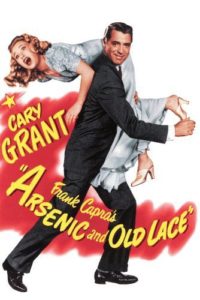 Frank Capra, screenwriters Joseph & Philip Epstein, and a perfect cast of performers adapt Joseph Kesserling’s Broadway smash (whose success delayed the release of this film by THREE years) into the ultimate zany black comedy. Set on Halloween night, this breathless farce concerns the murderous goings-on of the crazy Brewster clan and the frantic efforts of the one not-insane Brewster, “Mortimer” (Cary Grant), to get all his relatives (safely) committed.
Frank Capra, screenwriters Joseph & Philip Epstein, and a perfect cast of performers adapt Joseph Kesserling’s Broadway smash (whose success delayed the release of this film by THREE years) into the ultimate zany black comedy. Set on Halloween night, this breathless farce concerns the murderous goings-on of the crazy Brewster clan and the frantic efforts of the one not-insane Brewster, “Mortimer” (Cary Grant), to get all his relatives (safely) committed.
But even HIS sanity is put to the test as the evening progresses… There’s his brother “Teddy” (John Alexander), who operates under the delusion that he’s the 26th President, charging up the stairs which he thinks is San Juan Hill and burying bodies which he thinks are victims of Yellow Fever in the basement, which he thinks is the Panama Canal; there’s his elderly aunts, “Abby and Martha” (Josephine Hull and Jean Adair), who, in their doily-laced collars and long, bustling skirts, treat lonely travelers to their own ‘family blend’ of elderberry wine (mixed with arsenic, of course); and, most of all, there’s the ill-fated return of the long prodigal eldest Brewster brother, “Jonathan” (Raymond Massey), who has has acquired, through botched plastic surgery (courtesy of Peter Lorre’s “Dr. Einstein”!), a rather unfortunate resemblance to a certain horror movie star (“?”)
If there’s one thing classic Hollywood movies did well, it’s comedy, and this lightning-paced production strikes just the right balance between the over-the-top proceedings and their delightfully sinister undertones. Perfect Halloween viewing.
Haunting Miscellany!
In the original play, the part of the plastic surgery-disfigured, psychopathic gangster Jonathan Brewster was actually PLAYED by Boris Karloff, and this served to make the joke that much funnier whenever any of the characters pointed out the resemblance. Karloff was unavailable for the movie—he was touring with the stage production at the time—but actor Raymond Massey acquitted himself brilliantly under Perc Westmore’s make-up (the “Frankenstein”-like facelift scars are a particularly nice touch) and with a spot-on “Karloff” impersonation.
It’s one among several notes of off-the-wall (even off-the-hook!) humor that shows director Frank Capra at his zaniest, descending the soap box of “social relevance” he at times ascended during otherwise charming pre-war dramadies like Mr. Deeds Goes to Town (1936), Mr. Smith Goes to Washington (1939), and Meet John Doe (1941), and is certainly the purest comedy in his oeuvre since his days making silent slapstick features with comedian Harry Langdon (The Strong Man, Long Pants). Again, it seems that Capra, at the time also engaged in making Why We Fight documentaries for the U.S. Army, also bowed to the public’s demand for something less heavy and more fun. Posterity, I’d say, couldn’t be more delighted!
19th Night: BLITHE SPIRIT
(1945, UK, dir. David Lean)
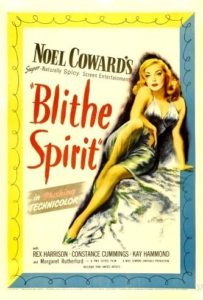 More macabre fun, this time courtesy of playwright Noël Coward and (future) director of epics, David Lean.
More macabre fun, this time courtesy of playwright Noël Coward and (future) director of epics, David Lean.
Mystery writer “Charles Condomine” (Rex Harrison), researching his latest thriller, organizes a séance at his cottage in the English countryside—during which the spirit of his first wife (Kay Hammond) is summoned (accidentally) from the Great Beyond. The subsequent ‘haunting’ wreaks immediate havoc on his SECOND marriage (Constance Cummings)… And that’s just the beginning as further marital and spiritual complications ensue!
During this period in his career, Lean was most well known for adapting the works of Coward for the screen—he had served as a technical advisor (and credited co-director) on Coward’s naval wartime drama, In Which We Serve (1942), as well as previously adapting Coward’s between-the-war British family drama, This Happy Breed (1944)—but this is the first film Lean made for Coward, who served as producer, where visual effects clearly trump the witty and brittle dialogue for which Coward was known.
Shot in muted Technicolor (rather appropriate for its rainy English setting), Lean and his technicians came up with several inventive (and visually compelling) means to suggest the ghostly presence of the spirit(s)—including a light-green makeup design and glow-in-the-dark costumes for the ghostly presence of Condomine’s late first wife, “Elvira” (Kay Hammond), and subtle lighting effects courtesy of cinematographer Ronald Neame. Margaret Rutherford is hilarious in her star-making performance as the eccentric and energetic medium, “Madame Arcati.” Also of note is a surprising twist that changes the ending of the original play.
Haunting Miscellany!
Squarely in the tradition of ghostly comedies and romantic fantasies like The Ghost Goes West (1936),Topper (1937), I Married a Witch (1941), and The Canterville Ghost (1944)—the tradition would continue the following year with Rex Harrison himself playing a ghostly suitor in 20th Century Fox’s The Ghost and Mrs. Muir (1946)—Blithe Spirit offers a pleasant, if slightly naughtier (I mean, the comic situation of a man living with both his living and dead wives suggests not only bigamy, but necrophilia!), variation on spiritualistic goings-on and screwball romance from beyond the grave.
As a point of confession here, after seeing it performed by the American Players Theatre in Spring Green, Wisconsin in the summer of 2011, I very foolishly attempted a 50,000 word, fanfictive “Fourth Act” to Coward’s three-act play, and by extension this film, in which it is revealed that the medium, Madame Arcati, had been the sole author of these otherworldly romantic entanglements in order to drive the husband mad and, for her own dark, inscrutable purposes, take possession of the house! Though I’d cringe to look at it today (I’m reasonably certain all copies have been chucked out, burned, or deleted) I feel I can nonetheless personally attest to the natural, and of course not-so natural, storytelling appeal of This World clashing against The Next — especially for comedy! (Or, in my case, the entirely unintentional kind.)
20th Night: THE BODY SNATCHER
(1945, RKO, dir. Robert Wise)
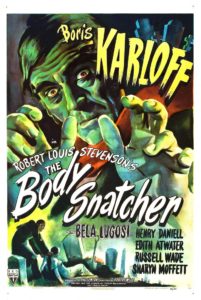 From 1942 to 1946, RKO producer Val Lewton made a series of low-budget ‘program fillers’ (*movies with a short-running time designed to fit the bottom of a double feature), many of which are now regarded as some of the finest Hollywood genre pictures ever made. Director Robert Wise’s The Body Snatcher, based on a Robert Louis Stevenson story, is one of Lewton’s finest, with Boris Karloff sinister and frightening (what else?) as a ‘cabman’ in 1830’s Edinburgh who—shades of the infamous early 19th century graverobbers, Burke & Hare—digs up corpses from graveyards and sells them to a medical college.
From 1942 to 1946, RKO producer Val Lewton made a series of low-budget ‘program fillers’ (*movies with a short-running time designed to fit the bottom of a double feature), many of which are now regarded as some of the finest Hollywood genre pictures ever made. Director Robert Wise’s The Body Snatcher, based on a Robert Louis Stevenson story, is one of Lewton’s finest, with Boris Karloff sinister and frightening (what else?) as a ‘cabman’ in 1830’s Edinburgh who—shades of the infamous early 19th century graverobbers, Burke & Hare—digs up corpses from graveyards and sells them to a medical college.
Naturally, “Cabman Gray” soon resorts to murder when the local gendarmes start guarding the cemeteries and the dedicated, though somewhat austere and morally questionable, “Dr. MacFarlane” (Henry Daniell), heir to the real-life Burke & Hare associate, Dr. Knox, continues to demand a steady supply of medical cadavers. For horror fans, though, the film is most notable as the very last to feature the final on-screen team-up of Karloff and Bela Lugosi. The pair, who had at this point vied for screen dominance in four horror movies together (I’m not really counting 1940’s Black Friday as in that film they didn’t have any mutual scenes), attained a level of intensity in their perhaps all-too-convincing enmity that translates to pure screen electricity.
Bottom-billed Lugosi, who due to drug addiction, multiple marriages, and personal debt had come down considerably in the movie-making world, is here given one crackerjack of a terrific screen send-off when he, playing the mentally feeble medical college dogsbody, “Joseph,” (very foolishly) attempts to blackmail the evil cabbie… The gaping maw of Poverty Row and the delirious ambitions of one Edward D. Wood, Jr. opened up and swallowed Mr. Lugosi whole in his remaining years on the fringes of Hollywood, but here he’s given a final moment of truly blood-curdling glory!
Haunting Miscellany!
While Val Lewton’s psychologically terrifying films dealt only tangentially with supernatural themes, horror aficionados have championed the series for decades due to the films’ ability to conjure up a dark and eerie atmosphere… without once showing a disfigured monster or a set drenched in blood.
Lewton took control of RKO’s unofficial “B” unit in the wake of the studio’s release of Orson Welles’ Citizen Kane(1941), and Lewton’s stylistic choices—bold framing, unusual angles, and atmospheric, low-key lighting—along with his films’ unconventional approaches to narrative—some employ a flashback structure, and many others end on a note best-described as “unresolved”—clearly demonstrate a style of Hollywood filmmaking, no less than Welles’ breakthrough classic, that had reached its maturity. Beginning with a collaboration between director Jacques Tourneur and writer DeWitt Bodeen, in which Lewton, Tourneur, and Bodeen were tasked by the studio to make “some kind of horror movie” from the ridiculous title of Cat People (1942), the eight features that followed—including such classics as I Walked with a Zombie (1943; another studio-forced title), The Leopard Man (1943), and the film under discussion, The Body Snatcher—all ran under 80 minutes, were produced very quickly, and, most importantly, at a minimal cost to the studio.
Part of Lewton’s “suggestive” style of filmmaking was due to economics—many of the films were shot on half-finished or leftover sets from other features (indeed, 1943’s Satan Cult thriller The Seventh Victim was mostly filmed in interiors Orson Welles had used for his second feature, 1942’s The Magnificent Ambersons), while the dim lighting served to conceal the productions’ low-cost—but, ultimately, Lewton and his collaborators posited that anything the viewer might imagine within their chiaroscuro compositions would be far scarier than anything that could be created through make-up or flashy effects.
21st Night: 50s TRIPLE CREATURE FEATURE!
If the movies are any judge, the 50’s were a rather disquieting period, with fears ranging from the irrational (i.e., alien invasion) to the very real (i.e., the looming threat of nuclear armageddon). The horror and science fiction genres mined these fears for their entertainment value, creating some of the most memorable creatures committed to celluloid. Following is a few prime examples of ‘monstrosity!’ from that anxious decade:
Take 1: The Threat From Above!
THE THING FROM ANOTHER WORLD
(1951, RKO, dir.(s) Christian Nyby & Howard Hawks)
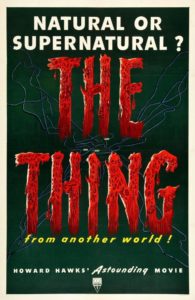 Howard Hawks’ study of group dynamics under a pressure situation is just about the most realistic depiction you’ll find of how a ‘first contact’ situation might actually unfold. Remade (sorta) by John Carpenter in 1982 (as The Thing; entirely different, though equally scarifying), the original features a giant, unstoppable vegetable-based life form (described by one character as an “intellectual carrot”) that feeds on animal blood… And it’s really much more frightening than it sounds!
Howard Hawks’ study of group dynamics under a pressure situation is just about the most realistic depiction you’ll find of how a ‘first contact’ situation might actually unfold. Remade (sorta) by John Carpenter in 1982 (as The Thing; entirely different, though equally scarifying), the original features a giant, unstoppable vegetable-based life form (described by one character as an “intellectual carrot”) that feeds on animal blood… And it’s really much more frightening than it sounds!
Take 2: The Inescapable Threat!
THEM!
(1954, Warner Bros., dir. Gordon Douglas)
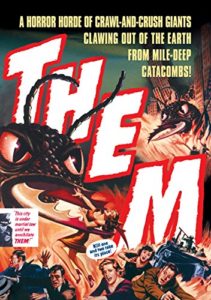 The atomic age sparked fears of genetic mutation from radiation exposure… which, in turn, inspired a whole rash of “giant nuclear monster” movies. If this (often-dubious) sub-genre has its Citizen Kane, though, it’s undoubtedly Them! Imagining a giant ANT invasion as a potentially apocalyptic event, the movie is infused with a documentary-like reality that makes a viewer feel the full threat of the (admittedly ridiculous-sounding) situation.
The atomic age sparked fears of genetic mutation from radiation exposure… which, in turn, inspired a whole rash of “giant nuclear monster” movies. If this (often-dubious) sub-genre has its Citizen Kane, though, it’s undoubtedly Them! Imagining a giant ANT invasion as a potentially apocalyptic event, the movie is infused with a documentary-like reality that makes a viewer feel the full threat of the (admittedly ridiculous-sounding) situation.
Take 3: The Threat From Within!
INVASION OF THE BODY SNATCHERS
(1956, Allied Artists, dir. Don Siegel)
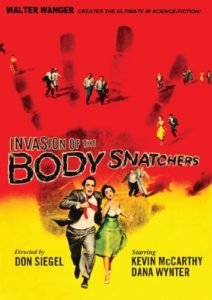 Possibly the most remade, adapted, refashioned, AND parodied science fiction/horror movie of all time, the original has been alternately interpreted as a cautionary tale about conformity, a commentary on social apathy, or an allegory about the unchecked spread of Communism. With its depiction of an entire population corrupted and replaced by exact replicas of THEMSELVES, though, one can’t help being reminded of an observation made by cartoonist Walt Kelly (Pogo) at the height of the political witch hunts of the 1950’s: “We have met the enemy and he is us.” Surely the most frightening monster of them all!
Possibly the most remade, adapted, refashioned, AND parodied science fiction/horror movie of all time, the original has been alternately interpreted as a cautionary tale about conformity, a commentary on social apathy, or an allegory about the unchecked spread of Communism. With its depiction of an entire population corrupted and replaced by exact replicas of THEMSELVES, though, one can’t help being reminded of an observation made by cartoonist Walt Kelly (Pogo) at the height of the political witch hunts of the 1950’s: “We have met the enemy and he is us.” Surely the most frightening monster of them all!
Haunting Miscellany!
Only one of these great genre pictures contains an actual exclamation point in its title (Them!; so-named for the screaming, single-word description given by a little girl, whose family was slaughtered and eaten by giant ants before her very eyes, upon jolting awake from a catatonic stupor), but I think all certainly deserve one.
Growing up in the 80’s, network television (the “big three” of NBC, ABC, and CBS; FOX came along soon after) was still the dominant cultural force in this country and, at the time, was still re-running most of the programs my parents (both born in 1949) had themselves grown up on in the 50’s and 60’s. The Donna Reed Show, Father Knows Best, and (especially) Leave it to Beaver; all presented a white, middle-class, suburban, squeaky-clean image of normality and middle-American contentment—but beneath that placid exterior, one surmises, lurked discontentment, fear, and mass hysteria!
Or at least that’s what the evidence of these horror/scifi pics seems to suggest. With their stalwart, square-jawed heroes (James Arness in Them!, Kevin McCarthy in Body Snatchers) and sometimes brainy, though more often drippy and tight-bloused, heroines (Joan Weldon, Dana Wynter)—in grudging cooperation with those egg-headed scientists (Edmund Gwenn in Them!; Robert Cornthwaite, though not so helpfully, in The Thing)—the disruption to All-American values were entertainingly put through their genre paces by the ever-lurking threat from above (The Thing), below (Them!), or within (Body Snatchers), and undoubtedly lead to their success with film audiences.
22nd Night: PEEPING TOM
(1960, UK, dir. Michael Powell)
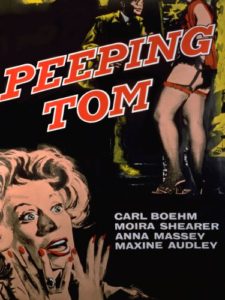 Premiering the same year as Alfred Hitchcock’s Psycho (1960), Peeping Tom also concerns a serial killer of women (Carl Boehm) given to voyeurism. But where Hitchcock’s movie was greeted with instant acclaim (on the American side of the pond, at least), Michael Powell’s unsettling account of a young assistant cameraman and his bizarre, murderous fetish for the eye of a camera was vilified in the British press, shunned by the public, and ended up virtually destroying the renowned filmmaker’s career.
Premiering the same year as Alfred Hitchcock’s Psycho (1960), Peeping Tom also concerns a serial killer of women (Carl Boehm) given to voyeurism. But where Hitchcock’s movie was greeted with instant acclaim (on the American side of the pond, at least), Michael Powell’s unsettling account of a young assistant cameraman and his bizarre, murderous fetish for the eye of a camera was vilified in the British press, shunned by the public, and ended up virtually destroying the renowned filmmaker’s career.
Powell, who with writer/producer Emeric Pressburger, billed mutually as “The Archers,” had been responsible for some of the most ravishing, astonishing, and exciting movies made during and after World War II. Though too numerous to mention, The Life and Death of Colonel Blimp (1943), Black Narcissus (1947), and The Red Shoes (1948) remain to this day the high-water mark for the British film industry.
Appearing himself in documentary inserts as the young killer’s late father, a famed behavioral psychiatrist who used his growing son as a guinea pig while researching the causes and effects of fear, Powell, as director/producer, seems intent as a filmmaker in showing, rather than merely suggesting, the seedy underbelly of British urban culture. (The film opens with a direct cut on a long, single take of the murderer meeting a prostitute in a slum, following her upstairs to her squalid bed-sit, and fatally slashing her with a pointed metal object protruding from the camera!)
While many speculate that the fury stemmed from Powell’s stylistic decision to film the murders from the murderer’s perspective (AS he’s ‘shooting’ his murders!), personally I think the entire hullaballo boiled down to a five-second shot of a murder victim sprawled nude on a bed. THAT’s what really ruffled everyone’s feathers! In any event, “Banned in England!” has such a nice ring to it and, as cinephiles the world over can tell you, any film that’s earned the distinction is well-worth a look-see…
Haunting Miscellany!
As long as we’re mentioning ‘firsts,’ where Peeping Tom might have been the first British film to contain a shot of a nude woman, Psycho has its own unusual distinction as the first American film to show a toilet in a bathroom. (Seriously!) One surmises that American film audiences, after over 25 years of Hollywood self-censorship, were perhaps now ready for such a shocking image (finally!), but director Powell, in his first sole filmmaking venture since his days churning out “Quota Quickies” during the 1930’s, seriously overestimated his own audience’s changing tastes.
Peeping Tom came at a time when British society, historically glacial to accept any sort of change whatsoever, actually was changing—the Empire had crumbled, the class system was breaking down to the point of virtual disintegration—but still, there were certain topics, themes, and images for the British moviegoing public (fetishistic sexuality, murderous voyeurism, and, well, a woman’s bare breasts, respectively) that were not quite cricket!
23rd Night: THE EXTERMINATING ANGEL
(1962, Mexico, dir. Luis Buñuel)
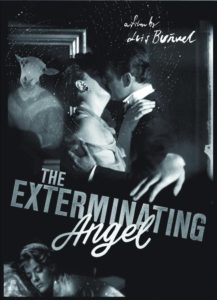 A group of wealthy elite gathers for an elaborate dinner party… and find they can’t leave the room when the evening ends. Days, weeks pass and the guests—inexplicably ‘trapped’—resort to an escalating series of humiliations in order to survive. One by one, the illusions of cultured society recede, dissipate, and disappear as these members of the upper crust are reduced to the basest forms of savagery…
A group of wealthy elite gathers for an elaborate dinner party… and find they can’t leave the room when the evening ends. Days, weeks pass and the guests—inexplicably ‘trapped’—resort to an escalating series of humiliations in order to survive. One by one, the illusions of cultured society recede, dissipate, and disappear as these members of the upper crust are reduced to the basest forms of savagery…
Obviously, the passing of 30 years certainly hadn’t mellowed the enfant terrible who made L’Age d’Or and here Buñuel came up with one of his more outrageous concepts. Part of the power of a Buñuel film is how a completely ludicrous situation is played absolutely straight—I mean, his actors might as well be performing in a stiff TV drama—and, moreover, how faultless the internal logic of each increasingly bizarre plot development is. As such, the conclusion to all the preceding insanity is PERFECT… and, of course, completely logical. Again, a surrealist art film seems an unlikely candidate for a Halloween-themed movie, but as with many great horror movies Buñuel here smuggles in some still-timely and subversive themes that continue to gain relevance.
Haunting Miscellany!
What makes a horror movie? In the late 90’s I justified about 70% of what was to become a $20,000 student debt loan by sitting in on a guest lecture given by the philosopher and humanities scholar Noël Carroll.
In the lecture, Professor Carroll presented his “Philosophy of Horror” from his 1990 book of the same name in which he theorized that all horror movies must, as an essential convention of the genre, start with a monster or force of terror existing beyond the realm of probability. Dracula, Frankenstein’s Monster, The Mummy—monsters, all; but your grave-robbers, your axe-wielding maniacs, your disfigured musical geniuses plotting destruction and terror in the sewers beneath the Paris Opera House, remarkable though they all might be, are merely maladjusted psyches in the final analysis, and therefore subject to the laws of science. Thrillers, tales of suspense and/or terror, yes; horror movies, no. On the other hand, the unexplained, the metaphysical, the supernatural… this is what makes a true monster, and by extension what makes a true horror movie, precisely because vampires, ghouls, and ghosts cannot be explained away by rational or scientific laws.
The Exterminating Angel offers an interesting proposition as, again, we’re dealing here with mysterious goings-on for which a scientific cause cannot be determined. Is ‘the exterminating angel’ a monster? Can we attribute the terrifying happenings and outré situations the film presents to some unknowable, guiding force? Who knows. But it’s the presentation of a reality different from our own—with the possibility that there’s a fiendish, supernatural intelligence behind it all—which, according to the argument, makes The Exterminating Angel a definitive horror movie.
24th Night: THE TOMB OF LIGEIA
(1964, American International Pictures/Alta Vista Productions, dir. Roger Corman)
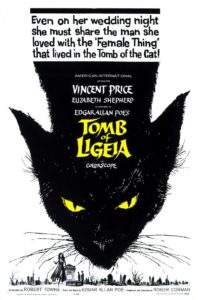 From 1960 to 1964, director Roger Corman made 8 films based on the works of Edgar Allan Poe, 7 of which starred Vincent Price. Some are campy (The Raven, Tales of Terror), some are creepy (House of Usher, The Pit and the Pendulum), some have little-to-no relationship to anything Poe ever wrote (The Premature Burial, The Haunted Palace), but all are great, great fun.
From 1960 to 1964, director Roger Corman made 8 films based on the works of Edgar Allan Poe, 7 of which starred Vincent Price. Some are campy (The Raven, Tales of Terror), some are creepy (House of Usher, The Pit and the Pendulum), some have little-to-no relationship to anything Poe ever wrote (The Premature Burial, The Haunted Palace), but all are great, great fun.
The final two in the series, however—The Masque of the Red Death and, this one, The Tomb of Ligeia—are flat-out masterpieces. An Anglo-American co-production shot in East Anglia, Norfolk, this particular entry is notable for shooting much of its scenes outside in the bright daylight; justifying the dark-tinted glasses Price’s light-sensitive character, “Verden Fell,” haunted by the spirit of his titular dead wife (Elizabeth Shepherd), wears throughout. Where Corman’s previous Poe movie, Masque, relied on elaborate artifice and theatricality for its impact, Ligeia uses real locations—a ruined monastery and a ‘stroll through Stonehenge’ are particular standouts—and utilizes vivid, visceral camerawork and editing, from British technicians Arthur Grant and Alfred Cox, respectively, for its no-less shock-inducing effects.
And gosh, Vincent Price in a horror movie? Really, you just can’t go wrong there…
Haunting Miscellany!
The list of movies ‘inspired by an Edgar Allan Poe story’ is rather long; the list of ‘Poe movies’ actually (or even) resembling their source material, however, is noticeably shorter. I’ve never read the story this movie’s based on—“Ligeia”—but, nonetheless, Corman’s Ligeia rather ‘goes for broke,’ Poe-wise, by throwing in just about every element one usually associates with the master of horror.
From the ‘haunted and tormented’ man still in love with his dead wife, a ‘roving black cat’ that suggests a living embodiment of evil, to a ‘restless spirit’ whose influence is felt far beyond the grave, Corman’s Liegeiamay well be the ultimate Poe movie. And, of course, that it all builds to a conclusion that (none-too subtly) sums up the morbid proceedings in a spectacular display of property destruction (shades ofUsher) certainly doesn’t hurt the argument!
25th Night: THE FEARLESS VAMPIRE KILLERS
(1967, US/UK (MGM), dir. Roman Polanski)
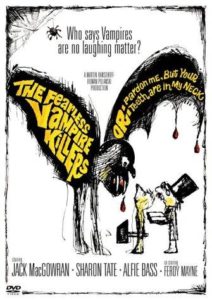 Originally titled Dance of the Vampires (and then ridiculously expanded by greedy producers to include the Swinging Sixties subtitle, “Pardon Me, But Your Teeth Are in My Neck”), Roman Polanski’s kooky vampire comedy is also one of the most beautiful-looking horror movies ever made. Set in 19th century Transylvania (natch!), bumbling “Professor Abronsius” (Jack MacGowran) and his clumsy apprentice, “Alfred” (played by director Polanski), wage (feeble) battle against a band of aristocratic vampires at a snowbound Gothic castle.
Originally titled Dance of the Vampires (and then ridiculously expanded by greedy producers to include the Swinging Sixties subtitle, “Pardon Me, But Your Teeth Are in My Neck”), Roman Polanski’s kooky vampire comedy is also one of the most beautiful-looking horror movies ever made. Set in 19th century Transylvania (natch!), bumbling “Professor Abronsius” (Jack MacGowran) and his clumsy apprentice, “Alfred” (played by director Polanski), wage (feeble) battle against a band of aristocratic vampires at a snowbound Gothic castle.
Along the way this Laurel & Hardy pair of warriors against the supernatural encounter the screen’s first proletarian, and not to mention Jewish, vampire (Alfie Bass as the innkeeper, “Shagal;” who has the film’s single funniest line when a female victim holds up a cross to ward him off and he simply shrugs, saying, “Boy, have you got the wrong vampire!”), the screen’s first overtly homosexual vampire (Iain Quarrier as The Count’s son; a “sensitive youth” who compares young Alfred’s “lashes” to “golden threads”), and an elaborate vampire’s ball(!) that serves as the film’s climactic danse macabre.
A pure delight from beginning to end, the ravishing winter landscapes of Central Europe come to vivid life in rich Metrocolor and through (cinematographer) Douglas Slocombe’s gorgeous widescreen compositions. (An animated prologue, excised from many prints, and Krzysztov Komeda’s shrieking score add to the fun.) I’d willingly sacrifice a couple pints of blood to see this one on the big screen!
Haunting Miscellany!
Director Polanski, who considers himself a “cosmopolitan filmmaker,” made his first short features, and first feature, Knife in the Water (1962), in his native Poland before emigrating to England where he made his next three features, which include Repulsion (1965), Cul-de-Sac (1966), and this film. His first Hollywood feature was made the very next year, Rosemary’s Baby (1968), but personally I thinkVampire Killers is a good deal more fun, and an even more accomplished film both in terms of film style and its transgressive treatment of well-worn genre tropes.
With Vampire Killers, Polanski unites the technical professionalism of Alfred Hitchcock with the New Wave sensibility of Francois Truffaut; his angles, choice of camera lens, use of widescreen, and, especially, brilliant realization of production designer Wilfrid Shingleton’s expansive interiors result in “pure cinema” sequences straight out of the silent slapstick days—a chase scene, done in one long take, where the assistant, pursued by his gay vampire admirer, ends up exactly back where he started after dutifully running around a square balcony is a particular favorite of mine—yet has a style and sophistication that never seems too broad precisely because, as a director, Polanski in no way spares the dark and menacing atmosphere of his genre forebears.
26th Night: TOBY DAMMIT
(1968, France/Italy, dir. Federico Fellini)
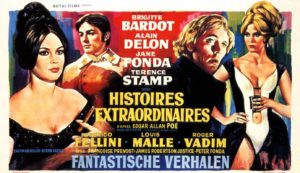 Originally the last chapter of a French/Italian anthology movie adapting three works by Edgar Allan Poe (1969’s Spirits of the Dead), Fellini’s Toby Dammit stands on its own as an hallucinatory commentary on fame and celebrity—pet themes of the director—with a horror twist. Terence Stamp (perhaps THE most underrated actor of the 1960s) is brilliant as the title character, “Toby Dammit”: a washed-up, alcoholic English actor who is lured to Rome, where he’s set to star in a “Western about Christ”, with the promise of a cherry-red Ferrari convertible.
Originally the last chapter of a French/Italian anthology movie adapting three works by Edgar Allan Poe (1969’s Spirits of the Dead), Fellini’s Toby Dammit stands on its own as an hallucinatory commentary on fame and celebrity—pet themes of the director—with a horror twist. Terence Stamp (perhaps THE most underrated actor of the 1960s) is brilliant as the title character, “Toby Dammit”: a washed-up, alcoholic English actor who is lured to Rome, where he’s set to star in a “Western about Christ”, with the promise of a cherry-red Ferrari convertible.
Haunted from his arrival by visions of the Devil (perversely imagined as a little girl in a white dress bouncing a white ball), Dammit grows increasingly unhinged through the airport press conference, TV interview, and awards ceremony that follows—culminating in the moment when he finally takes the wheel of his Ferrari… ‘Twould be a disservice to reveal more, but I will simply add that this short film is “liberally adapted” from a Poe story called “Never Bet the Devil Your Head,” which you will understand should you choose to see the movie! No other director could better portray the subjective reality of his characters and, here, Fellini conjures up a frightening hellscape of glittering emptiness as seen through the eyes of the beautiful and damned.
Haunting Miscellany!
Mixing the hollow world of disintegrating celebrity from Fellini’s most famous film, La Dolce Vita (1960; which even gave us the word paparazzi, named after that movie’s tabloid photographer character) with the dreams, visions, and even hallucinations suffered by the male and female protagonists of 8 ½(1963) and Juliet of the Spirits (1965), Toby Dammit plays like every movie Fellini had made over that past ten years crammed into a 37-minute running time.
Personally, I find Fellini a bit hard to take as a filmmaker—his carnivalesque surreality often comes off labored and wearying; his style about as subtle as a sledgehammer—but, boy, in his first (and to my knowledge only) genre picture, it really works. Horror movies push its subject matter and its manner of presentation to the edge of extremity, and the more wildly-indulgent its treatment of transgressive themes—here: celebrity, perversion, and self-destruction—and film style—again: glaring, overexposed images starkly portrayed against purposely abstract, smoke-screened backgrounds—the more successful its impact on audiences.
So yeah, maybe Fellini shoulda chucked in that arthouse junk and become a horror moviemaker, huh?
27th Night: EVEN DWARFS STARTED SMALL
(1970, West Germany, dir. Werner Herzog)
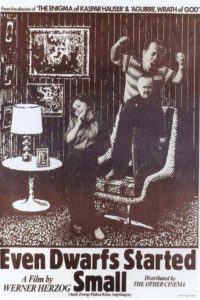 Pissing off the PC Cops bang off the title, film director/documentarian/cinema alchemist Werner Herzog, in his second feature film, gleefully serves up 96 minutes of sustained madness that has something guaranteed to offend everyone.
Pissing off the PC Cops bang off the title, film director/documentarian/cinema alchemist Werner Herzog, in his second feature film, gleefully serves up 96 minutes of sustained madness that has something guaranteed to offend everyone.
Filmed entirely on location off the coast of Spain, the film is set on a remote island that, for unexplained reasons, is populated entirely by dwarfs. A group of inmates ‘revolt’ against their ‘keepers’ (also dwarfs) at the island’s mental asylum, during which the diminutive malcontents commit various atrocities including (but not limited to) smashing windows, setting flower pots on fire, destroying an automobile, tormenting a pair of blind fellow inmates, slaughtering a pig, and, in a mock-religious ceremony, crucifying a monkey. (WARNING: Animals WERE harmed in the making of this film.
And I must admit the last is a bit much even for ME.) Herzog’s mad genius level of cinematic intuition—I mean, who else would be able to make scenes of such profound screen poetry out of burning flowers or, in the film’s most haunting image, a van running around in circles with no one at the wheel?—is on full display here, clearly prefiguring several subsequent reality-transgressing movie moments which include (but, again, are not limited to) a raft on the Amazon overrun by howler monkeys (Aguirre, the Wrath of God, 1972), an entire village of mass-hypnotized hysterics (Heart of Glass, 1976), an eternally dancing chicken on slot-machine display at an off-season winter sports resort (Stroszek, 1977), and, it goes without saying, a large ship being dragged up the side of a mountain (Fitzcarraldo, 1982)!
Haunting Miscellany!
To me, in the act of viewing this film, what’s most frightening watching each increasingly bizarre plot unfold is the thin-line Herzog walks between documentary and fiction film, most disturbingly because a fair percentage of the people appearing on screen are (quite obviously) NOT performers or actors.
In other words, it’s sometimes hard to tell, as the fever pitch of mass hysteria increases, how much was staged for the non-professional small actors and how much was merely “allowed to occur.”
As such, this film, even more than others Herzog made subsequently, seems at times to appear as something uncomfortably close to reality, despite the admitted irreality of its situations and setting. Entertainment, Art, or Exploitation? It’s up to each viewer to decide, but I’d further warn that this film certainly isn’t for the easily-offended, the right-thinking, the sober-minded, OR the faint of heart… For the rest of us, though, a fascinating, if disturbing, viewing experience. Would make an absolutely brilliant double-bill with a film that has already appeared on this list, Tod Browning’s Freaks!
28th Night: CRIES AND WHISPERS
(1972/3, Sweden, dir. Ingmar Bergman)
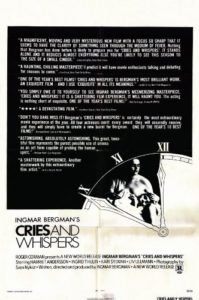
Y’know, maybe if they got rid of the art and credits they coulda had more room for a few more blurbs?
In 1957, Swedish film director Ingmar Bergman gained international recognition for The Seventh Seal—his moody, allegorical tale of a medieval knight challenging the Grim Reaper to a game of chess. In the 15 years that followed, Bergman addressed the topic of death time and again—often in the context of religious doubt—but never as directly (or as forcefully) as in his 1972 feature, Cries and Whispers.
Set in the late 1800’s, the story concerns two sisters, “Karin” (Ingrid Thulin) and “Maria” (Liv Ullmann), who return to the family estate to care for their sister, “Agnes” (Harriet Andersson), who is dying of cancer. (Also caring for the dying sister, I should add, is her self-sacrificing maid, “Anna” (Kari Sylwan), who is as close to a Christ-like figure as one is likely to find in film history. Her callous dismissal by the bourgeois family following the sister’s eventual death for, basically, ‘services rendered’ is a truly heartbreaking moment.)
In typical Bergman fashion, we learn about the sisters’ troubled history through flashback, exploring each of the sisters’ strained childhood relationship with their late mother (also played by Ullmann), sister Maria’s infidelity with the local doctor (Erland Josephson), sister Karin’s psychological turmoil upon approaching middle age, sister Agnes’ harrowing physical agonies upon approaching her biological end… all building to a truly astonishing deathbed scene, and its frightening aftermath, that might cause your heart to skip a beat or two! Ultimately, the film is like looking DEATH square in the face for 90 minutes and, personally, I can’t think of any film, horror or otherwise, more frightening than Cries and Whispers.
Haunting Miscellany!
Of particular interest is the film’s deeply-saturated, almost garish, color photography, which most closely reminds me of splashy 1940’s and 50’s MGM musicals! The disconnect between the film’s visual scheme and its subject matter is disconcerting, to say the least, and was inspired, apparently, by a nightmare Bergman had entirely, and disturbingly, in stark red-and-white. Bergman, whose parents Karin and the Rev. Erik Bergman’s then-recent passing informed the conception and writing of the script, set out to explore the devastating effect illness and death can wreak on a family and, relying on long-term collaborators like cinematographer Sven Nykvist and production/costume designer Marik Vos-Lundh, realized his harrowing vision, both narratively and visually, in a manner no less foreboding or dreadful than any horror movie! (And perhaps moreso.)
On a very personal note, I myself spent a good deal of my childhood watching a parent suffer from cancer and find both the film’s realistic emotional treatment and subjective, almost expressionistic, execution and design (the sets literally seem to ‘swim’ before one’s eyes) painfully true. No, it’s not fun viewing, but with the film’s final sequence—a flashback to a summertime idyll showing the three sisters, wearing white dresses, enjoying each other’s company while languidly swinging in their estate’s backgrounds—satisfyingly wrests true emotional catharsis from the somber gloom during which the dead sister, Agnes, reads words of comfort from her personal diary to those that survive her: “And I feel profoundly grateful for my life, which gives me so much.”
Here, the perfect marriage of image and narration—in which actress Harriet Andersson so reminds me of my late mother—serves to remind one of, and be similarly grateful for, every day that one is alive and well.
29th Night: THE WICKER MAN
(1973, UK, dir. Robin Hardy)
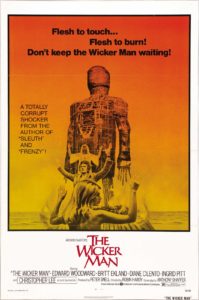 The one-and-only The Wicker Man concerns a chaste, pious Police Sergeant (Edward Woodward) who comes to a remote (and fictional) Scottish island called ‘Summerisle’ to investigate reports of a missing girl. Through his contacts with the affably uncooperative locals—including “Lord Summerisle” himself (Christopher Lee)—the devout “Sergeant Howie” grows increasingly horrified, and mentally unhinged, in reaction to witnessing the ancient fertility religion the island dwellers practice. The resulting conflict, as the villagers obstruct (to all appearances, rather pleasantly) each point of Sergeant Howie’s investigation, builds to a (startling) climax involving the title Pagan effigy.
The one-and-only The Wicker Man concerns a chaste, pious Police Sergeant (Edward Woodward) who comes to a remote (and fictional) Scottish island called ‘Summerisle’ to investigate reports of a missing girl. Through his contacts with the affably uncooperative locals—including “Lord Summerisle” himself (Christopher Lee)—the devout “Sergeant Howie” grows increasingly horrified, and mentally unhinged, in reaction to witnessing the ancient fertility religion the island dwellers practice. The resulting conflict, as the villagers obstruct (to all appearances, rather pleasantly) each point of Sergeant Howie’s investigation, builds to a (startling) climax involving the title Pagan effigy.
Written by playwright Anthony Shaffer (who received above-the-title credit), and directed by Robin Hardy, the film was re-cut for American distribution, resulting in a few lapses in logic and disjointed tonal shifts which nonetheless do little to distract from the bracing atmosphere that was (obviously) the most important part of the film’s production. Particular stand-out favorites: impromptu, mischievously suggestive love songs performed by the locals at the town’s pub; a colorful sequence with schoolchildren dancing ’round the Maypole; a prolonged fertility ritual where lovely young women jump nude through a bonfire (I must admit that is my, um, personal favorite scene; I mean, as Lord Summerisle helpfully points out, clothes would burn, right?); and the shocking final scene where the villagers, swaying hand-in-hand around the burning effigy, sing the eerie Middle English folk song “Summer Is Icumen In” while Sergeant Howie, inside the burning effigy, scream-chants Psalm 23 back to them.
Horror/mystery/thriller elements aside, The Wicker Man is a haunting portrait of a folk world that has somehow managed to survive into the modern age. The songs, rites, ceremonies, and way of life of these people are so vividly realized that, in viewing, you just might find yourself being sucked into the bewitching spell of their truly captivating world…
Haunting Miscellany!
The unfortunate trend of remaking classic horror movies yields both the tolerable (2004’s remake of the 1978 classic Dawn of the Dead) and the not-so-good (2007’s remake of the also-1978 classicHalloween), but once in a-blue-moon-while there comes a remake SO misguided, calamitous and, not to mention, absolutely indefensible that its merely having been made actually detracts from the original. (If familiar with the internet meme “Oh, no! Oh,no! Not the Bees!” you might know of what I speak.) So, it’s better in some cases, I think, just to pretend some movies were never made and, moreover, to agree, collectively, to forget that they even exist…
Far as I know, then, there’s only one The Wicker Man. (Or so I will keep telling myself!)
30th Night: YOUNG FRANKENSTEIN
(1974, 20th Century Fox, dir. Mel Brooks)
“It’s pronounced… FRONCK-EN-STEEN.”
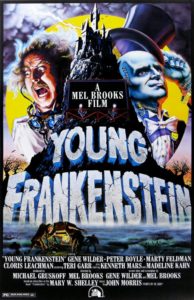 Yup, Young Frankenstein is, bar-none, the funniest movie ever made. (Of course, some might disagree, but those people are lacking both in taste and a sense of humor and they have my profound pity.) Mel Brooks’ side-splitting send-up/loving parody of all the great Universal monster classics takes on new and added depth when one has compared it to its immediate sources of inspiration—in particular, Frankenstein, Bride of Frankenstein, 1939’s Son of Frankenstein, and 1942’s The Ghost of Frankenstein.
Yup, Young Frankenstein is, bar-none, the funniest movie ever made. (Of course, some might disagree, but those people are lacking both in taste and a sense of humor and they have my profound pity.) Mel Brooks’ side-splitting send-up/loving parody of all the great Universal monster classics takes on new and added depth when one has compared it to its immediate sources of inspiration—in particular, Frankenstein, Bride of Frankenstein, 1939’s Son of Frankenstein, and 1942’s The Ghost of Frankenstein.
Shot in glorious black-and-white, set to John Morris’ haunting score, and with precisely-recreated art direction and set design (utilizing props and laboratory equipment from the original film), Young Frankenstein is a near-miraculous act of cinematic resurrection. Co-writer Gene Wilder, as “Dr. Frederick Frankenstein” (grandson of the original “Dr. Frankenstein”), hilariously channels the hysterical histrionics of Frankenstein (1931) actor Colin Clive (“We shall command the thunders, and penetrate into the very womb of impervious nature herself!”), leading a brilliant ensemble that includes British comedian Marty Feldman as hunchbacked “Igor” (“No, it’s pronounced EYE-gor.”), Madeline Kahn as fiancée (“Financier? Financee?”) “Elizabeth,” Kenneth Mars as wooden-armed, thickly Teutonic-accented “Inspector Kemp” (“A riot is an ugly t’ing… Und I think it’s just about time we had one!”), a growling Peter Boyle as the zipper-necked “Creature” (HrmHrmHrm dee RITZ!”), an impossibly young and lovely Teri Garr as laboratory assistant “Inga” (“What knockers!”), and Cloris Leachman as menacing housekeeper “Frau BLÜCHER!” (<cue neighing horses>).
Not only does the film capture the look of the original series, but the tone and feel as well… and then absolutely skewers all of the above to brilliantly comic effect! All said and done, it’s simply funny as hell—which is reason enough.
Haunting Miscellany!
“Ovaltine?” “Seda-GIVE?” “footschteps” and, of course, “schwanstücker”: Some comedies, I’d argue, are so indelible in their impact on audiences that it takes but a single word to let others ‘in the know’ to what you are referring. (In fact, obscure and obnoxious reference-making happens to make up about 90% of my job at a used bookstore as pop culture enthusiasm approaches something of a religion among my similarly nerdy and obsessive co-workers.)
Comedy gets a bad rap among critics, perhaps because it’s the most ephemeral and difficult style of performance to explain or defend. It’s so ‘in the moment,’ where timing is literally everything, that taken out-of-context, and in describing such classic sequences on paper (or, um, ‘internet text’) as, say, Young Frankenstein delivering an impassioned monologue on the “preservation of life!” before accidentally stabbing himself in the thigh with a scalpel, or meeting his hunchbacked assistant, Igor, at the Transylvania Station and receiving an explanation that “the rates” of hunchbacked assistant-ry “have gone up,” or Master and Creature immortally performing a softshoe rendition of Irving Berlin’s “Puttin’ On the Ritz,” they in toto lose precisely 100% of their humor and appeal.
So to praise Mel Brooks and his accomplishment here would almost be a disservice, but nonetheless I have seen this movie about 3 times a year ever since I taped it off a late-night showing on Public Television back in 1993 — a scant few months after my mother’s death — and now that I’ve enjoyed it on tape, on DVD, and, most recently, on Blu-Ray (I have yet to see it on the big screen, alas), I feel that I must at least say something to express my appreciation for all the ways Young Frankenstein has actually enriched my life and made the intolerable ever-so-slightly more tolerable…
Fortunately, there does happen to be one word that might explain exactly what I’d want to say about this movie and that word, again, is “BLÜCHER!!!!” <NEIGHHHH!>
[Though it certainly didn’t start out this way, mostly because I like to start at the beginning and end at the end, this admittedly quite incomplete list somehow became a very condensed history of horror movies/tales of the suspense & macabre from 1922 – 1979. 1978 saw the release of both John Carpenter’s Halloween and George A. Romero’s Dawn of the Dead, and greater explicitness would subsequently dominate the mainstream release of horror movies into the next decade, so my final selection, I suppose, could be seen as a fitting coda to the classical style of horror filmmaking. Hope you agree!]
[P.S. As a bonus, I’ve included a list of, I believe, 100 films (I haven’t exactly counted them) made between 1922 – 1979 which I considered for the 31 Nights of Halloween, but ultimately did not include. As we on the internet know, the sole point of movie list-making is to make others feel insecure about their movie-watching habits, so stick around after my discussion of my selection for 31st Night to see how your own viewing stacks up against that of an Obsessive Moviewatcher’s!]
31st Night: NOSFERATU THE VAMPYRE
(1979, West Germany, dir. Werner Herzog)
 Coming full circle on my final Halloween Night, Werner Herzog’s 1979 remake-cum-reimagining of F.W. Murnau’s 1922 vampire classic, Nosferatu—which occupies the very 1st Night on this month-long list of Halloween movies—improbably becomes the one, and perhaps only, artistic property to give credence to the always-dubious practice, especially in the horror genre, of cinematic repetition. Max Schreck’s inhumanly pale, insect/rodent/reptile-like vampire is resurrected in Klaus Kinski’s equally grotesque Creature of the Night—a harbinger of plague, pestilence, and (literally) thousands of white rats(!)—but here the horror descending upon the small Slovakian town of 19th century Wismar has the added dimension of beauty and poetry behind the terror!
Coming full circle on my final Halloween Night, Werner Herzog’s 1979 remake-cum-reimagining of F.W. Murnau’s 1922 vampire classic, Nosferatu—which occupies the very 1st Night on this month-long list of Halloween movies—improbably becomes the one, and perhaps only, artistic property to give credence to the always-dubious practice, especially in the horror genre, of cinematic repetition. Max Schreck’s inhumanly pale, insect/rodent/reptile-like vampire is resurrected in Klaus Kinski’s equally grotesque Creature of the Night—a harbinger of plague, pestilence, and (literally) thousands of white rats(!)—but here the horror descending upon the small Slovakian town of 19th century Wismar has the added dimension of beauty and poetry behind the terror!
Rescuing plot elements from Bram Stoker’s original novel—Dracula is again “Dracula” (Kinski), Harker is again “Harker” (Bruno Ganz), Renfield is again “Renfield” (as giddily played by avant-garde novelist, Roland Topor)—the singular cinematic sensibility of Herr Herzog nonetheless filters the bare bones of the vampire narrative through his fervid imagination. Indeed, though Herzog carefully stages his shadowy and artful compositions to closely remind viewers of those of his immediate cinematic forbear, F.W. Murnau, his own symphony of horror—most forcefully expressed in the film’s famous opening sequence, a vision of death as the camera slowly pans past a long line of preserved mummies—clearly stands apart; adding new dimensions that in no way detract from the original.
More specifically, Herzog’s singular vision of horror results in such haunting sequences as Harker’s discovery of Count Dracula’s ruined castle rising out of the mists of the Carpathians, thousands of white rats scurrying through the streets of a beautiful Medieval village, lines of black coffins subsequently carried through those very same streets, Lucy’s moment-of-decision as she strolls through the plague-ruined village square (a scene discussed at greater lengths below), and the Count’s rather, um, ‘matter-of-fact’ sexual attraction to his final victim, Lucy (Isabelle Adjani), as he gropes his way towards the sustenance of her neck!
As a very personal artistic project, Herzog attempts in no less amount of insane ambition (when compared to, say, filming on a flimsy raft in the raging Amazon or hypnotizing an entire cast of actors in high altitudes or, indeed, giving “mad” actor Klaus Kinski leading roles in no less than 5 of his movies!) to bridge 57 years of German history—across economic dissolution, barbarity, war, atrocities, defeat, and humiliation—by linking the New German Cinema of the 1970’s, a “fatherless” cinema disconnected from the preceding generation who sided by the Nazis, with images and themes from the legitimate German cinema of the prewar, pre-Hitler era; finding artistic inspiration and renewal from cinematic “grandfathers” such as Fritz Lang, G.W. Pabst, and, of course, F.W. Murnau.
Haunting Miscellany!
Director Herzog, who was brought up in the Bavarian Alps during and immediately after World War II, claims never to have used a telephone before he was 10 and never to have seen a movie before he was 17! Despite his late introduction to technology (and it always seems appropriate to me that so many of his movies deal with pre-technological societies or remote historical periods), Herzog shot his first films as a teenager (with a stolen camera, naturally) before even having actually viewed a movie and, it is tempting to assume, could be understood as having developed his unique aesthetic entirely outside the traditions and history of cinema.
When preparing this film, Herzog’s sole point of reference to the legacy of “vampire films,” he claims, was the Murnau original and Roman Polanski’s Dance of the Vampires (or The Fearless Vampire Killers, profiled on this list a few “Nights” back), from which, along with Bram Stoker’s novel of Dracula, he gleaned “the rules” of the vampire mythos—the mysterious journey into the heart of Central Europe, the ruined castle where the vampire dwells, the coffin where the vampire sleeps, the bloodlust of the vampire; night and darkness, garlic, crosses, the stake through the heart, and so on—before developing and adding his own thematic and stylistic notions about monsters and evil.
Most importantly, Herzog felt, a vampire movie should offer its viewer an actual entrance into the realm of the vampire, into something quite Other. The visionary quality for which Herzog is most famous, a haunting and otherworldly tone achieved through a close attention to equally beautiful and terrifying scenes of nature, lends itself brilliantly to such aforementioned scenes as Harker’s discovery of the ruined castle in the mountains or the overwhelming congestion of rats descending upon the village.
As a truly immortal sequence of the macabre, though, nothing in all the vast film literature of vampire flicks can best the sequence where Harker’s wife, Lucy, who at this point has figured out that the vampire is solely responsible for the outbreak of “plague” in the village, is shown from far above wandering through the town’s square as the few surviving townspeople sing and dance through the streets, the “pestilence” of white rats scurrying around their feet, hysterical in the knowledge that they are soon about to die. Swooping from above to camera hand-held shots of Lucy pushing her way through the truly mass hysterical tumultuous throng, Herzog replaces the sound with a sweet folk song from Soviet Georgia; whose polyphonic harmonies, together with the situation and images, seems to strip away the very barriers of reality between the film and its audience and suck its viewer, quite literally, into the Vampire’s World.
As Herzog notes, a film may end, but its images will stick with us; in a sense, then, such a sequence ensures that the film never ends. The true power of a horror film!
And now, as promised…
The List!
Pre-1930: Eerie German & Hollywood Silent Classics
THE AVENGING CONSCIENCE
(1914, Mutual Film Co., dir. D.W. Griffith)
THE GOLEM
(1920, Germany, dir.(s) Paul Wegener & Carl Boese)
DESTINY
(1921, Germany, dir. Fritz Lang)
WAXWORKS
(1924, Germany, dir. Paul Leni)
THE UNHOLY THREE
(1925, MGM, dir. Tod Browning)
FAUST
(1926, Germany, dir. F.W. Murnau)
THE UNKNOWN
(1927, MGM, dir. Tod Browning)
THE CAT AND THE CANARY
(1927, Universal, dir. Paul Leni)
THE MAN WHO LAUGHS
(1928, Universal, dir. Paul Leni)
WEST OF ZANZIBAR
(1928, Universal, dir. Tod Browning)
1930’s: Dark Urban/Exotic Melodramas, Monster & Mad Scientist Chillers
SVENGALI
(1931, Warner Bros., dir. Archie Mayo)
THE MAD GENIUS
(1931, Warner Bros., dir. Michael Curtiz)
WHITE ZOMBIE
(1932, United Artists, dir. Victor Halperin)
DOCTOR X
(1932, Warner Bros., dir. Michael Curtiz)
THE OLD DARK HOUSE
(1932, Universal, dir. James Whale)
THE MASK OF FU MANCHU
(1932, MGM, dir.(s) Charles Brabin & Charles Vidor)
DR. JEKYLL AND MR. HYDE
(1932, Paramount, dir. Rouben Mamoulian)
MYSTERY OF THE WAX MUSEUM
(1933, Warner Bros., dir. Michael Curtiz)
MURDERS IN THE ZOO
(1933, Paramount, dir. A. Edward Sutherland)
ISLAND OF LOST SOULS
(1933, Paramount, dir. Erle C. Kenton)
MARK OF THE VAMPIRE
(1935, MGM, dir. Tod Browning)
THE RAVEN
(1935, Universal, dir. Lew Landers)
MAD LOVE
(1935, MGM, dir. Karl Freund)
THE INVISIBLE RAY
(1936, Universal, dir. Lambert Hillyer)
DRACULA’S DAUGHTER
(1936, Universal, dir. Lambert Hillyer)
THE DEVIL-DOLL
(1936, MGM, dir. Tod Browning)
THE WALKING DEAD
(1936, Warner Bros., dir. Michael Curtiz)
SON OF FRANKENSTEIN
(1939, Universal, dir. Rowland V. Lee)
1940s: Spooky Comedies, Atmospheric Thrillers, More Monsters & Mad Scientists
THE DEVIL AND DANIEL WEBSTER
(1941, RKO, dir. William Dieterle)
I MARRIED A WITCH
(1942, United Artists, dir. René Clair)
CAT PEOPLE
(1942, RKO, dir. Jacques Tourneur)
FRANKENSTEIN MEETS THE WOLFMAN
(1943, Universal, dir. Roy William Neill)
I WALKED WITH A ZOMBIE
(1943, RKO, dir. Jacques Tourneur)
THE SEVENTH VICTIM
(1943, RKO, dir. Mark Robson)
SON OF DRACULA
(1943, Universal, dir. Robert Siodmak)
DAY OF WRATH
(1943, Denmark, dir. Carl Theodor Dreyer)
THE LODGER
(1944, 20th Century Fox, dir. John Brahm)
1940s: MORE Spooky Comedies, Atmospheric Thrillers, More Monsters & Mad Scientists
THE CANTERVILLE GHOST
(1944, MGM, dir.(s) Jules Dassin & Norman Z. McLeod)
THE UNINVITED
(1944, Paramount, dir. Lewis Allen)
HOUSE OF FRANKENSTEIN
(1944, Universal, dir. Erle C. Kenton)
HANGOVER SQUARE
(1945, 20th Century Fox, dir. John Brahm)
ISLE OF THE DEAD
(1945, RKO, dir. Mark Robson)
HOUSE OF DRACULA
(1945, Universal, dir. Erle C. Kenton)
THE BEAST WITH 5 FINGERS
(1945, Warner Bros., dir. Robert Florey)
DEAD OF NIGHT
(1945, UK, dir.(s) Cavalcanti & Charles Crichton & Basil Dearden & Robert Hamer)
BEDLAM
(1946, RKO, dir. Mark Robson)
ABBOTT & COSTELLO MEET FRANKENSTEIN
(1948, Universal, dir. Charles Barton)
1950s: Creature Features & Alien Invasion Sagas (+ a Hitchcock Comedy)
THE MAN FROM PLANET X
(1951, United Artists, dir. Edgar G. Ulmer)
HOUSE OF WAX
(1953, Warner Bros., dir. André de Toth)
INVADERS FROM MARS
(1953, 20th Century Fox, dir. William Cameron Menzies)
THE WAR OF THE WORLDS
(1953, Paramount, dir. Byron Haskin)
DONOVAN’S BRAIN
(1953, United Artists, dir. Felix E. Feist)
CREATURE FROM THE BLACK LAGOON
(1954, Universal, dir. Jack Arnold)
THE TROUBLE WITH HARRY
(1955, Paramount, dir. Alfred Hitchcock)
IT CAME FROM BENEATH THE SEA
(1955, Columbia, dir. Robert Gordon)
FORBIDDEN PLANET
(1956, MGM, dir. Fred M. Wilcox)
EARTH VS. THE FLYING SAUCERS
(1956, Columbia, dir. Fred F. Sears)
20 MILLION MILES TO EARTH
(1957, Columbia, dir. Nathan H. Juran)
1957 through 1960s: Period Chillers & Gory Bodice Rippers, Classy Thrillers, Foreign Art Films, and SCHLOCK!
THE CURSE OF FRANKENSTEIN
(1957, Hammer Studios, dir. Terence Fisher)
NIGHT OF THE DEMON
(1957/8, Columbia, dir. Jacques Tourneur)
HORROR OF DRACULA
(1958, Hammer Studios, dir. Terence Fisher)
THE REVENGE OF FRANKENSTEIN
(1958, Hammer Studios, dir. Terence Fisher)
VERTIGO
(1958, Paramount, dir. Alfred Hitchcock)
THE FLY
(1958, 20th Century Fox, dir. Kurt Neumann)
HOUSE ON HAUNTED HILL
(1959, Allied Artists, dir. William Castle)
THE TINGLER
(1959, Columbia, dir. William Castle)
THE MUMMY
(1959, Hammer Studios, dir. Terence Fisher)
BUCKET OF BLOOD
(1959, AIP, dir. Roger Corman)
HOUSE OF USHER
(1960, AIP, dir. Roger Corman)
13 GHOSTS
(1960, Columbia, dir. William Castle)
EYES WITHOUT A FACE
(1960, France, dir. Georges Franju)
BLACK SUNDAY
(1960, Italy/AIP, dir. Mario Bava)
LITTLE SHOP OF HORRORS
(1960, AIP, dir. Roger Corman)
THE PIT AND THE PENDULUM
(1961, AIP, dir. Roger Corman)
1960s: MORE Period Chillers & Gory Bodice Rippers, Classy Thrillers, Foreign Art Films, and SCHLOCK!
THE INNOCENTS
(1961, 20th Century Fox, dir. Jack Clayton)
CARNIVAL OF SOULS
(1962, Herts-Lion International Corp., dir. Herk Harvey)
WHATEVER HAPPENED TO BABY JANE?
(1962, Warner Bros., dir. Robert Aldrich)
THE BIRDS
(1963, Universal, dir. Alfred Hitchcock)
X: THE MAN WITH THE X-RAY EYES
(1963, AIP, dir. Roger Corman)
THE HAUNTING
(1963, MGM, dir. Robert Wise)
DEMENTIA 13
(1963, AIP, dir. Francis Ford Coppola)
SÉANCE ON A WET AFTERNOON
(1964, UK, dir. Bryan Forbes)
THE MASQUE OF THE RED DEATH
(1964, AIP, dir. Roger Corman)
REPULSION
(1965, UK, dir. Roman Polanski)
WITCHFINDER GENERAL
(1968, AIP, dir. Michael Reeves)
KILL, BABY, KILL
(1968, Italy, dir. Mario Bava)
HOUR OF THE WOLF
(1968, Sweden, dir. Ingmar Bergman)
1970s: Cult, Camp & Cronenberg
THE ABOMINABLE DR. PHIBES
(1971, AIP, dir. Robert Fuest)
THE DEVILS
(1971, UK, dir. Ken Russell)
MACBETH
(1971, Columbia, dir. Roman Polanski)
TWITCH OF THE DEATH NERVE
(1971/2, Italy, dir. Mario Bava)
SISTERS
(1973, AIP, dir. Brian De Palma)
THE PYX
(1973, Canada, dir. Harvey Hart)
THE LEGEND OF HELL HOUSE
(1973, 20th Century Fox, dir. John Hough)
DON’T LOOK NOW
(1973, UK, dir. Nicolas Roeg)
IT’S ALIVE
(1974, Warner Bros., dir. Larry Cohen)
PHANTOM OF THE PARADISE
(1974, 20th Century Fox, dir. Brian De Palma)
SHIVERS
(1975, Canada, dir. David Cronenberg)
ASSAULT ON PRECINCT 13
(1976, CKK Corp., dir. John Carpenter)
SUSPIRIA
(1977, Italy, dir. Dario Argento)
RABID
(1977, Canada, dir. David Cronenberg)
Happy Halloween, Film Fans!

